#Dream Machines 2015
Explore tagged Tumblr posts
Video
Stingray by Thomas Hawk
#America#Bay Area#California#Chevrolet#Chevy#Corvette#Dream Machines#Dream Machines 2015#HMB#Half Moon Bay#Northern California#SF#SF Bay Area#Stingray#USA#United States#United States of America#West Coast#auto#automobile#car#emblem#norcal#flickr
29 notes
·
View notes
Text
Sandra Newman’s “Julia”

The first chapter of Orwell's Nineteen Eighty-Four has a fantastic joke that nearly everyone misses: when Julia, Winston Smith's love interest, is introduced, she has oily hands and a giant wrench, which she uses in her "mechanical job on one of the novel-writing machines":
https://gutenberg.net.au/ebooks01/0100021.txt
That line just kills me every time I re-read the book – Orwell, a novelist, writing a dystopian future in which novels are written by giant, clanking mechanisms. Later on, when Winston and Julia begin their illicit affair, we get more detail:
She could describe the whole process of composing a novel, from the general directive issued by the Planning Committee down to the final touching-up by the Rewrite Squad. But she was not interested in the finished product. She 'didn't much care for reading,' she said. Books were just a commodity that had to be produced, like jam or bootlaces.
I always assumed Orwell was subtweeting his publishers and editors here, and you can only imagine that the editor who asked Orwell to tweak the 1984 manuscript must have felt an uncomfortable parallel between their requests and the notional Planning Committee and Rewrite Squad at the Ministry of Truth.
I first read 1984 in the early winter of, well, 1984, when I was thirteen years old. I was on a family trip that included as visit to my relatives in Leningrad, and the novel made a significant impact on me. I immediately connected it to the canon of dystopian science fiction that I was already avidly consuming, and to the geopolitics of a world that seemed on the brink of nuclear devastation. I also connected it to my own hopes for the nascent field of personal computing, which I'd gotten an early start on, when my father – then a computer science student – started bringing home dumb terminals and acoustic couplers from his university in the mid-1970s. Orwell crystallized my nascent horror at the oppressive uses of technology (such as the automated Mutually Assured Destruction nuclear systems that haunted my nightmares) and my dreams of the better worlds we could have with computers.
It's not an overstatement to say that the rest of my life has been about this tension. It's no coincidence that I wrote a series of "Little Brother" novels whose protagonist calls himself w1n5t0n:
https://craphound.com/littlebrother/Cory_Doctorow_-_Little_Brother.htm
I didn't stop with Orwell, of course. I wrote a whole series of widely read, award-winning stories with the same titles as famous sf tales, starting with "Anda's Game" ("Ender's Game"):
https://www.salon.com/2004/11/15/andas_game/
And "I, Robot":
https://craphound.com/overclocked/Cory_Doctorow_-_Overclocked_-_I_Robot.html
"The Martian Chronicles":
https://escapepod.org/2019/10/03/escape-pod-700-martian-chronicles-part-1/
"True Names":
https://archive.org/details/TrueNames
"The Man Who Sold the Moon":
https://memex.craphound.com/2015/05/22/the-man-who-sold-the-moon/
and "The Brave Little Toaster":
https://archive.org/details/Cory_Doctorow_Podcast_212
Writing stories about other stories that you hate or love or just can't get out of your head is a very old and important literary tradition. As EL Doctorow (no relation) writes in his essay "Genesis," the Hebrews stole their Genesis story from the Babylonians, rewriting it to their specifications:
https://www.penguinrandomhouse.com/books/41520/creationists-by-e-l-doctorow/
As my "famous title" stories and Little Brother books show, this work needn't be confined to antiquity. Modern copyright may be draconian, but it contains exceptions ("fair use" in the US, "fair dealing" in many other places) that allow for this kind of creative reworking. One of the most important fair use cases concerns The Wind Done Gone, Alice Randall's 2001 retelling of Margaret Mitchell's Gone With the Wind from the perspective of the enslaved characters, which was judged to be fair use after Mitchell's heirs tried to censor the book:
https://en.wikipedia.org/wiki/Suntrust_Bank_v._Houghton_Mifflin_Co.
In ruling for Randall, the Eleventh Circuit Court of Appeals emphasized that she had "fully employed those conscripted elements from Gone With the Wind to make war against it." Randall used several of Mitchell's most famous lines, "but vest[ed] them with a completely new significance":
https://law.justia.com/cases/federal/appellate-courts/F3/268/1257/608446/
The Wind Done Gone is an excellent book, and both its text and its legal controversy kept springing to mind as I read Sandra Newman's wonderful novel Julia, which retells 1984 from the perspective of Julia, she of the oily hands the novel-writing machine:
https://www.harpercollins.com/products/julia-sandra-newman?variant=41467936636962
Julia is the kind of fanfic that I love, in the tradition of both Wind Done gone and Rosenkrantz and Gildenstern Are Dead, in which a follow-on author takes on the original author's throwaway world-building with deadly seriousness, elucidating the weird implications and buried subtexts of all the stuff and people moving around in the wings and background of the original.
For Newman, the starting point here is Julia, an enigmatic lover who comes to Winston with all kinds of rebellious secrets – tradecraft for planning and executing dirty little assignations and acquiring black market goods. Julia embodies a common contradiction in the depiction of young women (she is some twenty years younger than Winston): on the one hand, she is a "native" of the world, while Winston is a late arrival, carrying around all his "oldthink" baggage that leaves him perennially baffled, terrified and angry; on the other hand, she's a naive "girl," who "doesn't much care for reading," and lacks the intellectual curiosity that propels Winston through the text.
This contradiction is the cleavage line that Newman drives her chisel into, fracturing Orwell's world in useful, fascinating, engrossing ways. For Winston, the world of 1984 is totalitarian: the Party knows all, controls all and misses nothing. To merely think a disloyal thought is to be doomed, because the omnipotent, omniscient, and omnicompetent Party will sense the thought and mark you for torture and "vaporization."
Orwell's readers experience all of 1984 through Winston's eyes and are encouraged to trust his assessment of his situation. But Newman brings in a second point of view, that of Julia, who is indeed far more worldly than Winston. But that's not because she's younger than him – it's because she's more provincial. Julia, we learn, grew up outside of the Home Counties, where the revolution was incomplete and where dissidents – like her parents – were sent into exile. Julia has experienced the periphery of the Party's power, the places where it is frayed and incomplete. For Julia, the Party may be ruthless and powerful, but it's hardly omnicompetent. Indeed, it's rather fumbling.
Which makes sense. After all, if we take Winston at his word and assume that every disloyal citizen of Oceania is arrested, tortured and murdered, where would that leave Oceania? Even Kim Jong Un can't murder everyone who hates him, or he'd get awfully lonely, and then awfully hungry.
Through Julia's eyes, we experience Oceania as a paranoid autocracy, corrupt and twitchy. We witness the obvious corollary of a culture of denunciation and arrest: the ruling Party of such an institution must be riddled with internecine struggle and backstabbing, to the point of paralyzed dysfunction. The Orwellian trick of switching from being at war with Eastasia to Eurasia and back again is actually driven by real military setbacks – not just faked battles designed to stir up patriotic fervor. The Party doesn't merely claim to be under assault from internal and external enemies – it actually is.
Julia is also perfectly positioned to uncover the vast blank spots in Winston's supposed intellectual curiosity, all the questions he doesn't ask – about her, about the Party, and about the world. I love this trope and used it myself, in Attack Surface, the third "Little Brother" book, which is told from the point of view of Marcus's frenemy Masha:
https://us.macmillan.com/books/9781250757531/attacksurface
Through Julia, we come to understand the seemingly omniscient, omnipotent Party as fumbling sadists. The Thought Police are like MI5, an Island of Misfit Toys where the paranoid, the stupid, the vicious and the thuggish come together to ruin the lives of thousands, in such a chaotic and pointless manner that their victims find themselves spinning devastatingly clever explanations for their behavior:
https://www.bbc.co.uk/blogs/adamcurtis/entries/3662a707-0af9-3149-963f-47bea720b460
And, as with Nineteen Eighty-Four, Julia is a first-rate novel, expertly plotted, with fantastic, nail-biting suspense and many smart turns and clever phrases. Newman is doing Orwell, and, at times, outdoing him. In her hands, Orwell – like Winston – is revealed as a kind of overly credulous romantic who can't believe that anyone as obviously stupid and deranged as the state's representatives could be kicking his ass so very thoroughly.
This was, in many ways, the defining trauma and problem of Orwell's life, from his origin story, in which he is shot through the throat by a fascist: sniper during the Spanish Civil War:
https://www.rjgeib.com/thoughts/soldiers/george-orwell-shot.html
To his final days, when he developed a foolish crush on a British state spy and tried to impress her by turning his erstwhile comrades in to her:
https://en.wikipedia.org/wiki/Orwell%27s_list
Newman's feminist retelling of Orwell is as much about puncturing the myth of male competence as it is about revealing the inner life, agency, and personhood of swooning love-interests. As someone who loves Orwell – but not unconditionally – I was moved, impressed, and delighted by Julia.

Tor Books as just published two new, free LITTLE BROTHER stories: VIGILANT, about creepy surveillance in distance education; and SPILL, about oil pipelines and indigenous landback.
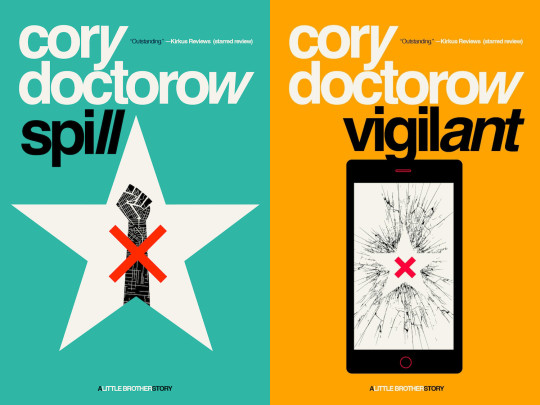

If you'd like an essay-formatted version of this post to read or share, here's a link to it on pluralistic.net, my surveillance-free, ad-free, tracker-free blog:
https://pluralistic.net/2024/09/28/novel-writing-machines/#fanfic
#pluralistic#reviews#books#orwell#george orwell#nineteen eighty-four#1984#little brother#fanfic#remix#gift guide#science fiction#sandra newman
699 notes
·
View notes
Text
Dragon Age: The Veilguard: Strangled by Gentle Hands
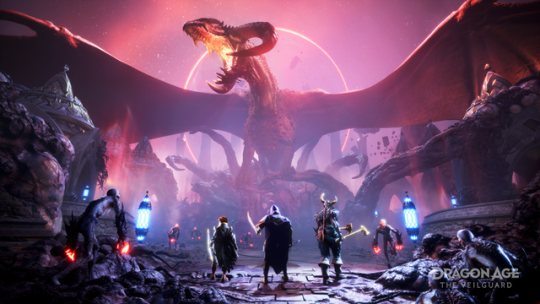
*The following contains spoilers*
“You would risk everything you have in the hope that the future is better? What if it isn’t? What if you wake up to find the future you shaped is worse than what was?”
– Solas, Dragon Age: Inquisition (2014)
I. Whatever It Takes
My premium tickets for a local film festival crumpled and dissolved in my pants pocket, unredeemed as they swirled in the washing machine. Throughout that October weekend in 2015, I neglected my celebratory privileges, my social visits to friends, and even my brutal honors literary theory class. All because a golden opportunity stretched before me: a job opening for a writing position at the once-legendary BioWare, with an impending deadline.
The application process wasn’t like anything I’d seen before. Rather than copy+paste a cover letter and quickly swap out a couple of nouns here and there, this opening required me to demonstrate my proficiency in both words and characters – namely, BioWare’s characters. Fanfiction wasn’t normally in my wheelhouse – at the time, I had taken mainly to spinning love sonnets (with a miserable success rate). But I wouldn’t balk at this chance to work on one of my dream franchises – especially since the job prospects for fresh English BAs weren’t exactly promising. So, I got to work crafting a branching narrative based on the company’s most recent title: Dragon Age: Inquisition. Barely two months prior, I saw the conclusion of that cast’s story when the Inquisitor stabbed a knife into a map and swore to hunt her former ally, Solas, to the ends of the earth. Now it was my turn to puppeteer them, to replicate the distinct voice of each party member and account for how they’d react to the scenario I crafted. And if it went well, then maybe I’d be at the tip of the spear on that hunt for Solas. Finishing the writing sprint left me exhausted, but also proud of my work.
The folks at BioWare obviously felt differently, because I received a rejection letter less than a week later. Maybe they found my story trite and my characterization inaccurate, or maybe they just didn’t want to hire a student with no professional experience to his name. Regardless, I was devastated. It wouldn’t be until years later that I learned that, had my application been accepted, I likely would’ve been drafted into working on the studio’s ill-fated looter shooter, Anthem (2019), noteworthy for its crunch and mismanagement. My serendipitous rejection revealed that sometimes the future you strive to build was never meant to match your dreams. What seemed like an opportunity to strike oil actually turned out to be a catastrophic spill.
Still, my passion for the Dragon Age series (as well as Mass Effect) persisted in the face of BioWare’s apparent decline. I maintain that Inquisition is actually one of the studio’s best games, and my favorite in the series, to the point where I even dressed up as Cole for a convention one time. The game came to me at a very sensitive time in my life, and its themes of faith vs falsehood, the co-opting of movements in history, and the instability of power all spoke to me. But I will elaborate more on that at a later date. My point is, I held on to that hope that, in spite of everything, BioWare could eventually deliver a satisfactory resolution to the cliffhanger from their last title. Or perhaps it was less hope and more of a sunk cost fallacy, as an entire decade passed with nary a peep from Dragon Age.
As years wore on, news gradually surfaced about the troubled development of the fourth game. Beginning under the codename “Joplin” in 2015 with much of the same creative staff as its predecessors, this promising version of the game would be scrapped two years later for not being in line with Electronic Arts’s business model (i.e. not being a live-service scam). Thus, it was restarted as “Morrison”. The project cantered along in this borderline unrecognizable state for a few years until they decided to reorient it back into a single-player RPG, piling even more years of development time onto its shaky Jenga tower of production. Indeed, critical pieces were constantly being pulled out from the foundations during this ten year development cycle. Series regulars like producer Mark Darrah and director Mike Laidlaw made their departures, and the project would go on to have several more directors and producers come and go: Matthew Goldman, Christian Dailey, and Mac Walters, to name a few key figures. They eventually landed on John Epler as creative director, Corinne Busche as game director, and Benoit Houle as director of product development. Then came the massive layoffs of dozens of employees, including series-long writer Mary Kirby, whose work still made it into the final version of DA4. Finally, the game received a rebranding just four months before release, going from Dreadwolf (which it had been known as since 2022) to The Veilguard (2024) – a strange title with an even stranger article.
Needless to say, these production snags did not inspire confidence, especially considering BioWare’s been low on goodwill between a string of flops like Anthem and Mass Effect: Andromeda (2017) and, before that, controversial releases like Dragon Age II (2011) and Mass Effect 3 (2012). The tumult impacted The Veilguard’s shape, which scarcely resembles an RPG anymore, let alone a Dragon Age game. The party size is reduced from four to three, companions can no longer be directly controlled, the game has shifted to a focus on action over tactics a la God of War (2018), the number of available abilities has shrunk, and there’s been a noticeable aesthetic shift towards a more cartoonish style. While I was open to the idea of changing up the combat (the series was never incredible on that front), I can’t get over the sensation that these weren’t changes conceived out of genuine inspiration, but rather vestigial traces from the live-service multiplayer iteration. The digital fossil record implies a lot. Aspects like the tier-based gear system, the instanced and segmented missions, the vapid party approval system, the deficit of World State import options, and the fact that rarely does more than the single mandatory companion have anything unique to say on a quest – it all points to an initial design with a very different structure from your typical single-player RPG. The Veilguard resembles a Sonic Drive-In with a mysterious interior dining area – you can tell it was originally conceived as something else.1
That said, the product itself is functional. It contains fewer bugs than any previous game in the franchise, and maybe BioWare’s entire catalog for that matter. I wouldn’t say the combat soars, but it does glide. There’s a momentum and responsiveness to the battle system that makes it satisfying to pull off combos and takedowns against enemies, especially if you’re juggling multiple foes at once. Monotony sets in after about thirty or forty hours, largely due to the fact that you’re restricted to a single class’s moveset on account of the uncontrollable companions. Still, this design choice can encourage replay value, as it does in Mass Effect, and free respec options and generous skill point allocations offset the tedium somewhat.
While the character and creature designs elicit controversy – both for the exaggerated art direction and, in the case of demons and darkspawn, total redesign – the environmental art is nothing short of breathtaking. I worried that this title would look dated because of how long it had been in development and the age of the technology it was built upon. Those fears were swiftly banished when I saw the cityscapes of Minrathous, the cyclopean architecture of the Nevarran Grand Necropolis, or the overgrown ruins of Arlathan. But like everything in The Veilguard, it’s a double-edged sword. The neon-illuminated streets of Docktown, the floating citadel of the Archon’s Palace, and the whirring mechanisms of the elven ruins evoke a more fantastically futuristic setting that feels at odds with all three previous titles (even though all three exhibited a stylistic shift to some extent). It aggravates the feeling of discordance between this rendition of Thedas and the one returning players know.

All of these elements make The Veilguard a fine fantasy action-adventure game – even a good one, I’d say. But as both the culmination of fifteen years of storytelling and as a narrative-based roleplaying game – the two most important facets of its identity – it consistently falls short. Dragon Age began as a series with outdated visuals and often obtuse gameplay, but was borne aloft by its worldbuilding, characterization, and dialogue. Now, that paradigm is completely inverted. The more you compare it to the older entries, the more alien it appears. After all these years of anticipation, how did it end up this way? Was this the only path forward?
Throughout The Veilguard’s final act, characters utter the phrase “Whatever it takes,” multiple times. Some might say too many. I feel like this mantra applied to the development cycle. As more struggles mounted, the team made compromise after compromise to allow the game to exist at all, to give the overarching story some conclusion in the face of pressure from corporate shareholders, AAA market expectations, and impatient fans. Whatever it takes to get this product out the door and into people’s homes.
This resulted in a game that was frankensteined together, assembled out of spare parts and broken dreams. It doesn’t live up to either the comedic heights or dramatic gravity of Inquisition’s “Trespasser” DLC from 2015, despite boasting the same lead writer in Trick Weekes. Amid the disappointment, we’re left with an unfortunate ultimatum: It’s either this or nothing.
I don’t mean that as a way to shield The Veilguard from criticism, or to dismiss legitimate complaints as ungrateful gripes. Rather, I’m weighing the value of a disappointing reality vs an idealized fantasy. The “nothing”, in this sense, was the dream I had for the past decade of what a perfect Dragon Age 4 looked like. With the game finally released, every longtime fan has lost their individualized, imaginary perfection in the face of an authentic, imperfect text. Was the destruction of those fantasies a worthy trade? It doesn’t help that the official artbook showcases a separate reality that could’ve been, with a significant portion dedicated to the original concepts for Joplin that are, personally, a lot closer to my ideal vision. I think it would’ve done wonders to ground the game as more Dragon Age-y had they stuck with bringing back legacy characters, such as Cole, Calpernia, Imshael, and the qunari-formerly-known as Sten.

I don’t necessarily hate The Veilguard (I might actually prefer it to Dragon Age II), but I can’t help but notice a pattern in its many problems – a pattern that stems from a lack of faith in the audience and a smothering commitment to safety over boldness. As I examine its narrative and roleplaying nuances, I wish to avoid comparing it to groundbreaking RPGs such as Baldur’s Gate 3 (2023) or even Dragon Age: Origins (2009), as the series has long been diverging from that type of old-school CRPG. Rather, except when absolutely necessary, I will only qualitatively compare it to Inquisition, its closest relative.
And nowhere does it come up shorter to Inquisition than in the agency (or lack thereof) bestowed to the player to influence their character and World State.
II. Damnatio Memoriae
No, that’s not the name of an Antivan Crow (though I wouldn’t blame you for thinking so, since we have a character named “Lucanis Dellamorte”). It’s a Latin phrase meaning “condemnation of memory”, applied to a reviled person by destroying records of their existence and defacing objects of their legacy. In this case, it refers to the player. When it comes to their influence over the world and their in-game avatar, The Veilguard deigns to limit or outright eliminate it.
Save transfers that allow for the transmission of World States (the carrying over of choices from the previous games) have been a staple of the Dragon Age and Mass Effect franchises. Even when their consequences are slight, the psychological effect that this personalization has on players is profound, and one of many reasons why fans grow so attached to the characters and world. At its core, it’s an illusion, but one that’s of similar importance to the illusion that an arbitrary collection of 1s and 0s can create an entire digital world. Player co-authorship guarantees a level of emotional investment that eclipses pre-built backgrounds.
However, The Veilguard limits the scope to just three choices, a dramatic decrease from the former standard. All import options come from Inquisition, with two just from the “Trespasser” expansion. One variable potentially impacts the ending, while the other two, in most cases, add one or two lines of dialogue and a single codex entry. Inquisition, by contrast, imported a bevy of choices from both previous games. Some of them had major consequences to quests such as “Here Lies the Abyss” and “The Final Piece”, both of which incorporated data from two games prior. The Veilguard is decidedly less ambitious. Conspicuously absent options include: whether Morrigan has a child or not, the fate of Hawke, the status of the Hero of Fereldan, the current monarchs of Fereldan and Orlais, the current Divine of the southern Chantry, and the individual outcomes of more than two dozen beloved party members across the series. Consequently, the fourth installment awkwardly writes around these subjects – Varric avoids mentioning his best friend, Hawke, as does Isabela ignore her potential lover. Fereldan, Orlais, and the Chantry are headed by Nobody in Particular. Morrigan, a prominent figure in the latest game, makes no mention of her potential son or even her former traveling companions. And the absence of many previous heroes, even ones with personal stakes in the story, feels palpably unnatural. I suspect this flattening of World States into a uniform mold served, in addition to cutting costs, to create parity between multiple cooperative players during the initial live-service version of Morrison. Again, the compromises of the troubled production become apparent, except this time, they’re taking a bite out of the core narrative.
Moreover, the game’s unwillingness to acknowledge quantum character states means that it’s obliged to omit several important cast members. At this point, I would’ve rather had them establish an official canon for the series rather than leaving everything as nebulous and undefined as possible. That way at least the world would’ve felt more alive, and we could’ve gotten more action out of relevant figures like Cassandra, Alistair, Fenris, Merrill, Cole, and Iron Bull. Not to mention that The Veilguard’s half-measure of respectful non-intereference in past World States ultimately fails. Certain conversations unintentionally canonize specific events, including references to Thom Rainier and Sera, both of whom could go unrecruited in Inquisition, as well as Morrigan’s transformation into a dragon in the battle with Corypheus in that game’s finale. But whatever personal history the player had with them doesn’t matter. The entire Dragon Age setting now drifts in a sea of ambiguity, its history obfuscated. It feels as gray and purgatorial as Solas’s prison for the gods.
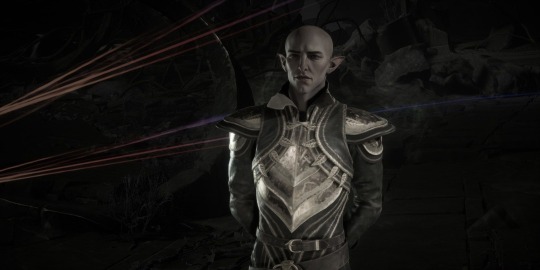
Beyond obscuring the past, The Veilguard restrains the player’s agency over the present. When publications first announced that the game would allow audiences to roleplay transgender identities and have that acknowledged by the party, I grew very excited – both at the encouraging representation, and at the depth of roleplaying mechanics that such an inclusion suggested. Unfortunately, The Veilguard offers little in roleplaying beyond this. The player character, Rook, always manifests as an altruistic, determined, friendly hero, no matter what the player chooses (if they’re offered choices at all). The selections of gender identity and romantic partner constitute the totality of how Rook defines themselves, post-character creation – exceptions that prove the rule of vacancy. Everything else is set in stone. The options presented are good, and should remain as standard, but in the absence of other substantive roleplaying experiences, their inclusion starts to feel frustratingly disingenuous and hollow, as if they were the only aspects the developers were willing to implement, and only out of obligation to meet the bare minimum for player agency. In my opinion, it sours the feature and exudes a miasma of cynicism.
Actual decisions that impact the plot are few and far between, but at least we have plenty of dialogue trees. In this type of game, dialogue options might usually lead to diverging paths that eventually converge to progress the plot. You might be choosing between three different flavors of saying “yes”, but as with the World States, that illusion of agency is imperative for the roleplaying experience. The Veilguard doesn’t even give you the three flavors – the encouraging, humorous, and stern dialogue options are frequently interchangeable, and rarely does it ever feel like the player is allowed to influence Rook’s reactions. Relationships with companions feel predetermined, as the approval system has no bearing on your interactions anymore. There are so few moments for you to ask your companions questions and dig in deep compared to Inquisition. Combined together, these issues make me question why we even have dialogue with our party at all. Rook adopts the same parental affect with each grown adult under their command, and it feels like every conversation ends the same way irrespective of the player’s input. With the exception of the flirting opportunities, they might as well be non-interactive cutscenes.
Rook’s weak characterization drags the game down significantly. With such limited authorship afforded to the player, it’s difficult to regard them as anything more than their eponymous chess piece – a straightfoward tool, locked on a grid, and moving flatly along the surface as directed.
III. Dull in Docktown
On paper, a plot summary of The Veilguard sounds somewhere between serviceable and phenomenal: Rook and Varric track down Solas to stop him from tearing down the Veil and destroying the world. In the process, they accidentally unleash Elgar’nan and Ghilan’nain, two of the wicked Evanuris who once ruled over the elven people millenia ago. With Solas advising them from an astral prison, Rook gathers a party together to defeat the risen gods, along with their servants and sycophants. Over the course of the adventure, they uncover dark truths about the origins of the elves, the mysterious Titans, and the malevolent Blight that’s served as an overarching antagonistic force. Eventually, Rook and friends join forces with Morrigan and the Inquisitor, rally armies to face off with their foes, and slay both the gods and their Archdemon thralls before they can conjure the full terror of the Blight. As Solas once again betrays the group, Rook and company have to put a decisive stop to his plans, which could potentially involve finally showing him the error of his ways.
The bones of The Veilguard’s story are sturdier than a calcium golem. Problems arise when you look at the actual writing, dialogue, and characterization – the flesh, blood, and organs of the work.

I’ve seen others chide the writing as overly quippy, but that better describes previous titles. Rather, I think The Veilguard’s dialogue is excessively utilitarian and preliminary, like a first draft awaiting refinement. Characters describe precisely what’s happening on screen as it’s happening, dryly exposit upon present circumstances, and repeat the same information ad nauseum. This infuriating repetition does little to reveal hidden components of their personalities, or their unique responses to situations. You won’t hear anything like Cole’s cerebral magnetic poetry or Vivienne’s dismissive arrogance. Many exchanges could’ve been uttered by Nobody in Particular, as it’s just dry recitation after recitation. It almost feels like watching an English second language instructional video, or a demonstration on workplace safety precautions. Clarity and coherence come at the cost of characterization and charisma.
Words alone fail to make them interesting. Most companions lack the subtlety and depth I had come to expect from the franchise, with many conversations amounting to them just plainly stating how they’re feeling. Most rap sessions sound like they’re happening in a therapist’s office with how gentle, open, and uncomplicated they feel. Compare this to Inquisition, where every character has a distinct voice (I should know, I had to try to copy them for that stupid application), as well as their own personal demons that it betrays: Sera’s internalized racism, hints of Blackwall’s stolen valor, Iron Bull’s espionage masked by bluster, or Solas’s lingering guilt and yearning for a bygone age. These aspects of their characters aren’t front and center, but things the audience can delve into that gives every moment with them more texture. The Veilguard’s companions lay out all their baggage carefullly and respectfully upfront, whether it’s Taash’s multiculturalism and gender identity issues or Neve’s brooding cynicism towards Tevinter’s underbelly. You’ve plumbed the depths of their personas within the first few minutes of meeting most of them.
Small exceptions exist. Professor Emmerich Volkarin stands out from the rest of the cast as a particularly inspired character: a charming, Vincent Price-like necromancer. His attachment to tombs and necromancy as a way to cope with his crippling fear of death makes for curiously compelling melodrama. The way in which he ultimately has to face his fear – either by foregoing his opportunity for immortality to save his beloved skeletal ward, Manfred, or by allowing his friend to pass on so that he can transcend into a new type existence – rises above the other binary choices in the game by being both narratively interesting and legitimately difficult to judge. Still, I feel Emmerich’s whole “lawful good gentleman necromancer” conceit, while a unique and clever subversion of tropes, would’ve worked better if it actually contrasted with anyone else in the party. Instead, the whole crew is full of unproblematic do-gooders who are forbidden by the game to nurture any meaningful interpersonal conflict. While I’d appreciate this lack of toxicity in my real-life relationships, fictional chemistry demands more reactive ingredients.

The Veilguard’s developers frequently positioned the game as “cozy” and about a “found family”, but I can guarantee you that there’s more tension at my Thanksgiving dinners than there is anywhere in this title. This family would get along swimmingly even during a presidential election. The thing about the “found family” trope is that it’s more satisfying when it’s earned. Here, it represents the default state, the starting point, and the status quo that they will always return to. Any minor squabbles (Harding wanting to sleep in the dirt, Emmerich taking too many books on a camping trip, Taash not liking necromancy) are introduced and squashed within the same scene. They all feel so extraneous. There’s so little friction among the companions here that you’d think it disproves Newton’s Third Law. The previous games never struggled in this regard, which makes the choices here all the more baffling.
Beyond the intra-party dynamics, characters lack grit or darkness to them – even when the narrative absolutely calls for it. Remember how I described the necromancer as lawful good (to use traditional Dungeons and Dragons alignments)? Yeah, that’s every character. Even the demonic assassin. Lucanis is a notorious hitman possessed by a demon of Spite, and possibly the weakest character of the game. This may or may not be due to the fact that his writer, Mary Kirby, was laid off mid-development. Regardless, he has noticeably less content than the other party members and generally feels unfinished. The demonic possession storyline goes nowhere; he doesn’t exorcise Spite, nor does he learn more about it or how to live with it. Instead, Spite is just an excuse to give Lucanis cool spectral wings (which he will use to fail several assassination attempts). The demon itself mostly just comes across as rude rather than threatening. The biggest issue, however, stems from the absence of any edge to Lucanis. When confronting his traitorous cousin, Ilario – the man who sold out Lucanis’s family to an enemy faction, kidnapped his grandmother, and made multiple attempts on his life – our grizzled, hardened assassin, pushed to the brink, demands… due process. Seriously, if your choices have led Lucanis to have a hardened heart, his method for dealing with the grievous traitor is sending him to jail. That’s The Veilguard’s idea of vindictive brutality among a clan of unforgiving murderers-for-hire. By contrast, Inquisition features Sera insubordinately murdering a stuck-up nobleman for talking too much. I believe that if modern BioWare had written The Godfather (1972), it would’ve ended with Michael Corleone recommending his brother-in-law to attend confession and seek a marriage counselor.
The writers seem intent on making the cast wholly unproblematic, with no way that the audience could ever question their morality or taste the delicious nuance of seeing someone you like do something bad. Measures were taken to child-proof every aspect of the good guys so that they couldn’t possibly be construed as anything else – even if it constricts them to the point of numbness and eventual atrophy.
To make things as palatable and accessible as possible, the language itself was dumbed down. Characters make frequent use of neologisms and bark phrases like “Suit up,” or “These guys go hard.” It emulates popular blockbuster superhero stuff rather than staying true to the diction the series traditionally employed. It’s all about the team, and the entire Dragon Age world has been stripped down into simplistic conflicts and recognizable stock characters.
This is why The Veilguard’s story largely fails. Despite being ostensibly being about the characters, they come off as an afterthought. Most of the time, only the sole requisite follower has anything to say on a given mission. Even in combat, their wholeness as fully-implemented party members falls short of expectations. Their damage output pales in comparison to the Rook’s, they have no health and cannot be downed in battle, and they mainly exist to give the player three extra ability slots. That’s the game’s true ethos for the companions, whether in combat or dialogue – utility, tools to make things happen rather than elegantly crafted identities. We end up with the largest amount of content per companion among any game in the franchise, only to have the weakest roster.
I know these writers can do better, because I’ve seen them do better. Trick Weekes wrote Iron Bull, Cole, and Solas in Inquisition, as well as Mordin Solus and Tali’Zorah in Mass Effect 2 (2010) and Mass Effect 3. Mary Kirby wrote Varric throughout the series, as well as Sten and Loghain in Origins. Plenty of other experienced writers, such as Sylvia Feketekuty and John Dombrow also contributed, so I can’t put any of the blame on a lack of skill. I don’t know if the mistake was trying to appeal to a wider audience, or if the constant reorientations of the DA4 project drained the crew’s passion and left them lacking in time to polish things.
I personally suspect that the writers had to rush out a script for all of the voiced dialogue. A video from August of 2020 showed off the voice actors for Davrin and Bellara, more than four years before the final game’s release. I think the codex entries, letters, and missives that you find throughout the game, which consist of only text, are much better written than the dialogue. My theory is that the writers had more time to revise and spruce up these tidbits, where edits were minimally invasive, as far as production is concerned. But my knowledge is limited; after all, BioWare rejected my application almost a decade ago.
Still, there are aspects of The Veilguard’s plot that I enjoy. The lore reveals were particularly satisfying2, and many felt rewarding after a decade of speculation. I called that elves were originally spirits, as well as the connection between the Archdemons and the Evanuris, but I wouldn’t have guessed that the Blight formed out of the smoldering rage of the Titans’ severed dreams. I’d concisely describe The Veilguard’s story as the opposite of Mass Effect 3: Whereas ME3 did excellent character work, the characterization in The Veilguard leaves much to be desired. Whereas ME3’s tone was overwhelmingly grim, The Veilguard feels inappropriately positive. Whereas ME3’s lore reveals ruined much about the series’s mystique, The Veilguard’s helped tie the setting’s history together. And whereas ME3 fumbled the ending about as much as it possibly could, The Veilguard actually coalesces into a spectacular third act.
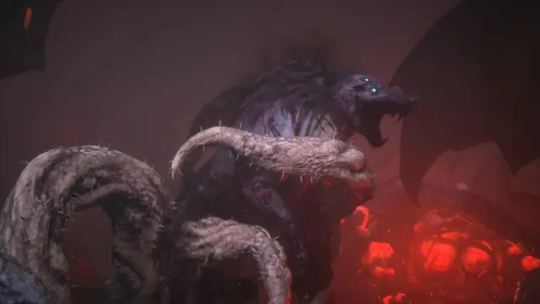
While I think the twist with Varric’s death is weak (outright pitiful compared to the Dread Wolf twist of Inquisition), the actual events that make up the finale carry a momentum and urgency that the rest of the game severely lacked. Everything from the sacrifice and kidnapping of Rook’s companions to the slaying of Ghilan’nain to the awe-inspiring battle between the Dread Wolf and Archdemon Lusacan – the whole affair takes the best parts of Mass Effect 2’s Suicide Mission and elevates it to the scale of an apocalyptic series finale. Ultimately, Solas takes center stage as the final antagonist, and the drama crescendos to a height the rest of the game desperately needed. He remains the most interesting character in the game and perhaps the franchise, and thankfully, the resolution to his story did not disappoint me (though I would’ve preferred the option for a boss battle against his Dread Wolf form if the player’s negotiations broke down). So in that sense, I think the worst possible scenario was avoided.
But is that really worth celebrating? Averting complete disaster? Exceeding the lowest standards? In many regards, The Veilguard still could have been – should have been – more.
IV. A World of Tranquil
In my essay on Final Fantasy VII: Rebirth (2024), I briefly discussed a trend in media to sand off the edges so as not to upset the audience in any way. The encroachment of this media sanitization seems to be an over-correction to the brimming grimness of late 2000s and early 2010s fiction (to which the first two Dragon Age titles belong), which earned comparable levels of criticism. Like Solas, I occasionally feel trapped in a cycle of regret, where it feels like our previous yearning for less aggressive, mean-spirited content led to a media landscape that prioritized patronizingly positive art. Now it’s clear to me that, in order to have a point, you need to have an edge.
Dragon Age historically drew a very progressive audience, and many of them congregated around Tumblr in that website’s heyday. Tumblr has garnered something of a reputation for overzealous discourse and sensitivity among its userbase, and I think that the developers of The Veilguard, in an attempt to cater to one of their core audiences, may have misunderstood both that passion and the fundamental appeal of their products. They became so concerned about optics, about avoiding politically charged criticism, that they kneecapped their world-building, rendering it as inoffensive and sterile as possible. It’s not so much “PC culture” as it is “PG culture.”
To that end, the various governments, factions, and societies of Thedas lost their edge. Dragon Age previously presented itself as anti-authoritarian by showcasing the rampant abuses of power across all cultures. Whether it was the incarceration of mages under the Chantry, the slavery practiced by the Tevinter Imperium, the expansionist anti-individualism of the Qun, the restrictive dwarven caste system, or the rampant racism against elves, social strife abounded in this world. I think that’s one thing that drew so many marginalized fans to the series. But the correlation of fictional atrocities with those of real life frequently prompted volatile discourse, with many concerned about how allegedly allegorized groups were being represented. You began to see countless essays pop up by folks who use the phrase “blood quantum” more than any healthy person should for a setting about wizards. BioWare responded to this by making Thedosian society wholly pleasant and the people in power responsible and cool and the disparate cultures tolerant and cooperative. If nothing’s portrayed negatively (outside of the cartoonishly evil gods), nobody can take offense, right?
For starters, the Antivan Crows have gone from an amoral group of assassins to basically Batman. These figures, which previously purchased children off slave markets to train them into killers, are now the “true rulers” of Antiva, by which the official government derives its authority. The Crows in The Veilguard stand against the insurgent qunari army as heroes of the common folk. They’re not an unscrupulous faction that Rook is reluctantly forced to ally with for the greater good; no, the Crows are simply good guys now. When the pompous governor of Treviso rails against them, with such audacious claims as “assassins and thugs should not represent the citizenry,” we’re meant to laugh at the governor’s foolishness. The unintentional implication this sends is that lethal vigilantism and unchecked power are cool because the people who use it are cool and stylish. The slave trade goes unacknoweldged; Antivan children want to grow up to be assassins now. The Crows never do anything wrong in The Veilguard – the governor is later revealed to be cooperating with the invaders for their own power. BioWare avoids the unpleasantness inherent in the Crows’ concept by pretending it never existed.
Perhaps more ridiculous is the Lords of Fortune, a new faction of pirates and treasure hunters based out of Rivain. Except they don’t really do piracy or treasure hunting. The game goes to lengths to ensure that the audience knows that the Lords don’t steal important cultural artifacts from any of the tombs and ruins they raid. What do they steal, then? There is no such thing as an ethical treasure hunter – plundering indigenous sites for souvenirs is inherently problematic – but the writers wanted to reap the appeal of adventurous swashbucklers without any of the baggage, regardless of whether it makes sense or not3. It comes across as a child’s idea of a pirate: they’re not thinking about the murder and looting, just the funny men with eye-patches who say “ARRR!” The developers want us to like the Lords of Fortune, and to that end, they can’t do anything culturally insensitive – even fictional disrespect toward a made-up culture. This is doubly amusing because the Lords are represented by Isabela from Dragon Age II. The same Isabela that kicked off a war with the qunari by stealing their holy book, the Tome of Koslun. This irony goes unacknowledged by the game.4
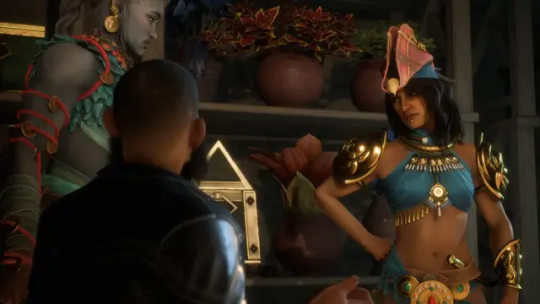
When these rogue buccaneers aren’t busy giving land acknowledgments to displaced Dalish elves or whatever, they’re enjoying their nonviolent coliseum. Pirates revel in bloodsport, but only so long as no actual blood is spilled. The Lords refuse to fight prisoners or animals in their arena, as they find such acts too cruel. I guess they’re all big Peter Singer readers. Instead, they summon spirits to adopt the visages of common enemies so that the player can kill them with a clean conscience. It’s another example of wanting to have your cake and eat it too – they wanted to create a glory hunter/gladiator faction, but couldn’t stand the underlying implications of such. So they twisted and bent them to fit into their unproblematic paradigm, leaving the Lords flavorless and lame. They barely even contribute to the main story, and they’re practically the only look we get into Rivaini society (which remains criminally underdeveloped).
More tragic is the handling of the qunari, once one of the most unique and nuanced civilizations in the Dragon Age setting. The Qun, as portrayed in the first three installments, is a society that demands all of its composite parts work in harmony. Thus, they have predetermined vocations for their children, rigid gender roles, strict codes of conduct, and an ambition to “enlighten” the rest of the world. While the Qun has often been presented as antagonistic toward the heroes, the series has commonly balanced its portrayal by showing how seductive its absolutism can be for people without hope. In some cases, life under the Qun is preferable, as is the case with former Tevinter slaves. Conformity becomes comfort when the world is regularly threatening to split apart.
The Veilguard opts for a different approach. See, Rook’s not fighting members of the Qun in this game – they’re fighting the Antaam, the former qunari military. The Veilguard constantly reiterates that the Antaam, which makes up one of the three branches of the Qun, has broken off and decided to invade, pillage, and stoke chaos. BioWare didn’t want the questionable morality and complexity of fighting an invading people from a humanized, multi-faceted culture, so they removed their culture. Their efforts to turn the non-Western-coded qunari into something digestible for their mistaken conception of a modern audience instead results in two caricatures: one being a fetishized, perfect society where there are no perceivable social ills; and the other a bunch of rampaging brutes.
Contending with a realized conception of Plato’s Republic mixed with the Ottoman Empire makes for more compelling drama than a horde of murderous giants. Again, BioWare wanted to have it both ways, and they still needed nameless, faceless orcs to kill. So every bit about the qunari’s militancy, imperialism, and repression coexisting alongside some of their more progressive ideas and communal unity is stripped of its context and meaning. Blame is placed solely on the Antaam, who no longer represent (and retroactively, never represented) the Qun’s ideology. It’s a cowardly compromise, attempting to pin the blame of all the Qun’s failings on a renegade military and seeking to exonerate the political and social apparatuses of their culpability.
At one point, a minor character named Seer Rowan lectures to an ignorant human (a proxy for the audience absorbing these retcons) that qunari society has always been egalitarian in practice, with mages enjoying freedom there. Previous games showed that the qunari shackle their “saarebas” mages, stitch their mouths, cut out their tongues, and teach them to commit suicide if they ever stray from their masters. However, we’re now assured that this is only practiced under the Antaam, and No True Qunari would ever do such a thing. Ignore the fact that, in Inquisition, we witness the enslaved saarebas under the supervision of the Ben-Hasserath, a subdivision of the Ariqun (i.e. not part of the Antaam). In fact, the Antaam that Rook fights in The Veilguard never command saarebas at all. They’re completely absent from the game (likely because the image of the bound, mutilated minority was too much for The Veilguard’s sensibilities). Seer Rowan’s weak, conciliatory retcon can’t even justify itself in its own game. The scolding diatribe communicates an intrinsic misunderstanding of the Qun by the writers – namely, it continues the pattern established with the Antivan Crows that the mechanics of power in society are fundamentally good as long as aberrant forces aren’t in charge. While I understand the desire to be conscientious about the portrayal of fictional cultures that draw upon non-Western traditions and iconography (which have historically been demonized in media), glamorizing the Qun and stripping it of its realistic nuance does little to alleviate any problems with representation. If anything, it creates new ones.
But hey, now we have our faceless orcs to guiltlessly slaughter. That’s what the Antaam’s been reduced to, bereft of the ideology that made them people. We kill them because they’re strange and scary and foreign and seeking to destroy our cities for fun. They remain the most prominent representation of the qunari in-game, barring our party member Taash. BioWare’s attempts to reverse what they viewed as problematic components to the qunari instead devolved into the very tropes they wished to avoid.
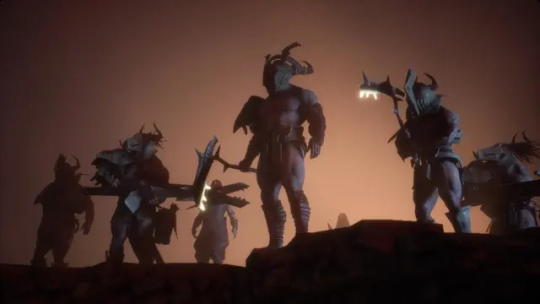
Which leads us to the elves. Much of the series’s discourse has surrounded the portrayal of the long-suffering elven people, who endure slavery under Tevinter, expulsion from their homeland in the Dales, confinement in ghettos, and the general disdain from other races. The games’ stories use symbolic shorthand of real-life oppressed peoples to communicate these tragedies, and this has led to a variety of intense, emotional interpretations over the years. The unending misery of the systematically marginalized elves hasn’t gone unnoticed by the fanbase – and their criticisms haven’t gone unnoticed by the developers. To quote The Veilguard’s creative director, John Epler, in an interview with Polygon:
“Dragon Age has not always been the kindest to the Dalish [elves]. Somebody once made a joke to me, and it’s not untrue, that it’s possible to wipe out a Dalish clan in all three of the games in some way.”
He and others on the development team must’ve thought elves needed a break, because the omnipresent racism against them vanishes completely in The Veilguard. Tevinter, an empire built on the back of chattel slavery, doesn’t show any of that. Consequently, it feels like players in the know still haven’t seen the true face of Tevinter, despite spending half a game there. The notion that the capital of Minrathous gives now is one of a prosperous city that’s centuries ahead of the countries down south, rather than a cruel regime cracking the whip at every opportunity. Perhaps the writers weren’t comfortable portraying this, or felt that their audience might not be amenable to it after years of incendiary argumentation. Nevertheless, it castrates their established world-building and robs us of the opportunity to witness true elven liberation in the climax. With both the fall of Minrathous and the toppling of the tyrannical elven gods, we could have delivered a much needed catharsis after four games of oppression, but The Veilguard forgoes this storytelling opportunity to play it safe.
I worry that this hesitancy originated from anxieties about the sensitivity of depicting marginalized peoples in brutal, dehumanizing conditions, and how that might look to more fragile viewers. But I think it’s important for all players, watchers, and readers to know that, though there might be aspects shared between them, fictional minorities are distinct from real ones.
Dragon Age’s elves are aesthetically Celtic. Their residency in alienages evokes images of Disapora Jews in Europe. Their Long Walk after being driven from the Dales calls back to the Trail of Tears, sharing an experience with Native Americans. Their subsequent migratory nature is reminiscent of the Romani people. And their ancient empire of Arlathan, with its large columns and temples of worship, headed by ascended humanoid (for lack of a better term) deities that cast down an enemy called the Titans, and which has since had its religion and culture co-opted and renamed by Roman-inspired Tevinter invites comparisons to classical Greece.
My point is, the elves of Dragon Age don’t represent one group of people, because fictional cultures are constructs drawing from countless inspirations. If they represent anything beyond themselves, it’s the idea of a proud people that’s fallen under the yoke of conquering powers – a supervictim to embody all. The idea that one must be limited in their storytelling options based on how the portrayal might reflect upon or disrespect an existing culture is flawed, in my opinion. In the overwhelming majority of cases, coding cannot be read as a 1:1 allegory, especially in speculative fiction like science-fiction and fantasy. I believe the most mature way to evaluate a story isn’t to try to pigeonhole what it’s trying to say say about who, as if there’s some insidious encrypted message in the text. Rather, it’s to see the forest through the trees and interpret the work as a complete whole in itself.
On that basis, I ask: would it have been so bad to see some of those enslaved elves, praying for salvation, side with their manipulative, nefarious gods? To add some nuance to the conflict with Elgar’nan and Ghilan’nain, would the story of elven liberation not have been better if the game actually engaged with it? Could we actually have a moral quandary with those whom Rook ends up fighting, even if the content might be seemingly problematic?
Epler might respond in the negative, per the Polygon interview, claiming that the gods “simply don’t care” about the elves.
“Those blighted, decrepit gods, they’re not bothering with the soft pitch. Their pitch is, We’re going to make a horrible world. We’re going to give you a lot of power, and maybe you’ll be OK.”
Like a chess board, the core conflict of The Veilguard is black and white. BioWare abandoned the chance to make Elgar’nan and Ghilan’nain more interesting villains because it was too risky.
Similarly risky was Solas’s role as an antagonist, since his motivations, as explained in “Trespasser”, are deeply sympathetic. Perhaps too much so for the developers’ comfort. Unlike the Evanuris and their disinterest in the elves, Solas wants to restore the elven people to their former glory. At least, that seemed to be his pitch in the last game. Frustratingly absent from The Veilguard are the Agents of Fen’Harel – elves who swore fealty to Solas’s cause. They infiltrated and compromised the Inquisition, effectively precipitating the final decision to end the organization in its current form. The idea that Solas had amassed an army of common folk who found the idea of a renewed elven empire appealing made him appear formidable and intimidating. “Trespasser” implies that a mass uprising of elves under Solas’s leadership was imminent, and anyone could be in on it.
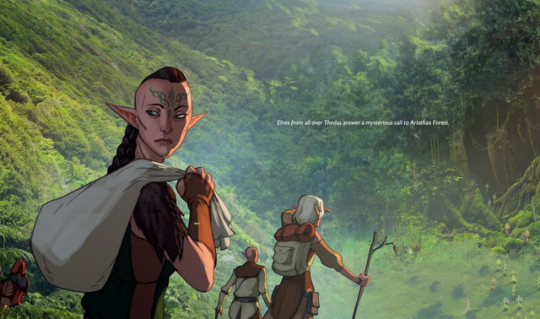
None of this happens in The Veilguard. Not only does Solas lack an army, but their absence isn’t explained or even acknowledged. As a result, Solas remains a passive antagonist until near the end, since the player has no disciples of his to contend with (either physically or ideologically) along the way. It wastes a side of his character that had been foreshadowed in a decade-long cliffhanger – that of a charismatic leader, capable of coordinating a rebellion that could spell disaster for its own followers.
In a Reddit AMA after the latest game’s release, Epler answered where the Agents of Fen’Harel disappeared to:
“Solas’ experience leading the rebellion against the Evanuris turned him against the idea of being a leader. You see it in the memories – the entire experience of being in charge ate at him and, ultimately, convinced him he needed to do this on his own. And his own motivations were very different from the motivations of those who wanted to follow him – he had no real regard for their lives or their goals. So at some point between Trespasser and DATV, he severed that connection with his ‘followers’ and went back to being a lone wolf. There are Dalish clans who are sympathetic to his goals, but even there, there’s an understanding that he’s too dangerous to have a more formal connection with, and that he will, ultimately, sacrifice them to his own ends if necessary.”
I find this explanation unsatisfying, not the least bit because the narrative offers next to nothing to imply this. The disappearance of Solas’s agents represents my biggest bugbear with the game, depriving it of the full potential of its highly anticipated antagonist in favor of the more generically villainous Evanuris. Moreover, this omission fits into the aggravating blueprint for The Veilguard’s inoffensive direction. The motivations, emotions, and backgrounds of the Agents of Fen’Harel would be sympathetic, and therefore might problematize the otherwise cut-and-dry conflicts. Epler seemed concerned that audiences might think Solas was “a little too sympathetic in his goals,” according to an interview with GamesRadar+.
But that’s the thing: sympathy isn’t endorsement, and portrayal of sympathetic characters isn’t endorsement either. But neither does that invalidate the emotions and experiences that generate that sympathy, even if the character’s actions ultimately turn toward evil. I’ve noticed a trend (especially in symptomatic criticism, which I generally dislike5) to view art as propaganda, and to evaluate it from a moralizing, top-down perspective. Antagonists with complex or understandable motivations (in this case, revolutionary villains) are often judged by this framework as tools for stories wishing to champion the status quo. Common arguments that I’ve seen imply that the relatability that we often find in villains is not a strength of the writing, but a devilish trick of ideology by which writers can reinforce conservative doctrine, to scold us away from certain beliefs. Any decent writer knows this isn’t the case, and that people don’t write morally or emotionally complex antagonists for didactic purposes. Instead, characters such as these embody the anxieties of their creators – the fear of losing yourself to your passions, the fear of going about things the wrong way, the fear of sacrificing too much to achieve your desired ends. The concepts and feelings that compel these characters remain authentic to the writer’s heart and the connection they established with the audience.
Art isn’t propaganda. To read it as such reduces it and promotes intellectual dishonesty and foolhardy myopia. Stories are irreducible (otherwise, we would not waste our time with them), and so I believe interpretations should be formed from the bottom-up, rooted in the text as much as possible. The “message” cannot be imposed from the top-down, but symptomatic readings, in their focus on tropes and cultural context, frequently condemn without a trial. Hindering your story in order to future-proof it for the sake of optics is a safeguard against this, and one that leads to bad stories. Artists should have confidence that their text will hold its ground on its own. To quote Ursula K. Le Guin’s essay “A Message about Messages”:
“The complex meanings of a serious story or novel can be understood only by participation in the language of the story itself. To translate them into a message or reduce them to a sermon distorts, betrays, and destroys them… Any reduction of that language into intellectual messages is radically, destructively incomplete.” (67-68)
BioWare’s doctrine of passive writing violates this wisdom by surrendering to their fear of (bad) criticism. The Veilguard lacks punch, stakes, and empathy and becomes incongruous with its established lore because it’s not willing to take risks that might alienate or upset players. They’re more concerned with making sure their work is inoffensive than they are with conveying a moving story.
I believe all of this was inherited from an incestuous feedback loop between a vocal minority of critics, of which I might’ve once counted myself among the blameworthy, and the apprehensiveness of out-of-touch corporate board room decision-making. Dragon Age’s genome mutated, and it slowly lost its teeth.
Over the course of a decade, we bred the Dread Wolf into a Dread Pug.
V. What It Took
The Veilguard’s lack of confidence in itself and lack of faith in its audience contribute to its capitulatory nature. In many respects, it feels like the developers lost their passion for it over the course of the ten year hellish production and just wanted to be done with it. This resulted in a decent game that nonetheless feels divorced from what came before it. It tries to juggle being a soft reboot while also trying to close out the series’s biggest and longest running story arcs, but inevitably fumbles.
Nearly everything done by The Veilguard was handled better by Inquisition. And Inquisition was certainly the more ambitious title. Perhaps more returning characters would have established a sense of continuity between the two, or at least made it less awkward by having them present for the story’s grand finale. For as strong as the endgame is, it could’ve benefited from the presence of slave liberator Fenris, elven history aficionado Merrill, possible Evanuris soul vessel Sera, or Divine Victoria (any of them). The core pillar of Dragon Age is the characters, and The Veilguard’s under-performance (and in some cases, outright dismissal) in that regard sabotages its integrity. Without this to anchor it, the changes to gameplay, visuals, and roleplaying depth become more alienating.
Personally, what do I take away from this? The Veilguard is far from the game I dreamed about for ten years, and not the one that loyal fans deserved either. I’m no stranger to disappointment at this point in my life, and yet this still leaves me with a hollow feeling. Will I still be able to return to Inquisition, a game I truly adore, and see it the same way as before, knowing now where all this is leading? The true cost of The Veilguard, for me, has nothing to do with the price tag: it’s the loss of that perfectly tailored dream, now that the possibilities of the future have shut their gates.
Where do those dreams go? Are they doomed to fester in their lonely, incommunicable agony? Will they be twisted by their enmity, like the blighted dreams of the Titans, and spread their corruption into those important happy memories?
In 2014, I was depressed as fuck, and Dragon Age: Inquisition helped me to see the light and come out of it. In 2024, I was depressed as fuck, and Dragon Age: The Veilguard made me feel nothing. There’s no less favorable comparison in my eyes. It’s disheartening to behold something that once meant so much to me and be greeted with numbness. I have to wonder if that affection will ever return, or if I’ve just grown out of it.
But as I wandered the streets of Minrathous as Rook, I heard a familiar song. It was one of the tavern songs from Inquisition, its nostalgic chords filling me with wistful sentiment. I know, deep down, there’s still something there. Maybe I just need to dig it up. Maybe it’s time to look back…
To be continued…
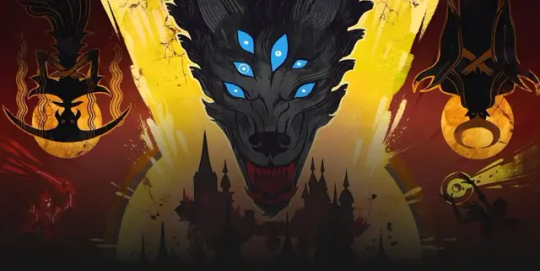
– Hunter Galbraith
Further Reading
Le Guin, Ursula K. “A Message about Messages.” Wonderbook: The Illustrated Guide to Creating Imaginative Fiction, Abrams Image, 2018, pp. 67–68.
Incidentally, this was an anomaly my friends and I pondered over and eventually solved. It turned out to be a former Wienerschnitzel. ↩︎
You could argue that this credit goes more to Inquisition and the previous games for laying the groundwork for said reveals, which were obviously planned out ahead of time, as confirmed by the aforementioned official artbook. Regardless, the payoff satisfied me and gave me proper closure. ↩︎
I’ve been informed that there is a hidden conversation that explains that the Lords of Fortune do, in fact, sell cultural artifacts at times, but only to the rightful owners. This just makes me wonder what they do with the artifacts if the prospective clients can’t pay. Do they shove them back in the ruins and re-arm all the booby traps? ↩︎
I would argue that this does not represent character progression on Isabela’s part, as her (possible, depending on the player’s choices) return of the Tome of Koslun in Dragon Age II was a pragmatic sacrifice she made to save her friends and the city, rather than an acknowledgment of the qunari’s inviolable ownership. In fact, in many continuities, she never returns the Tome at all. ↩︎
I prefer more formalist criticism because it allows the text to lead the dance, not the critique. I think it’s only fair, given that the creators likely spent more effort crafting the piece than I spent consuming it. Symptomatic criticism mandates that the reader consider everything around the text, typically at the text’s expense. In the worst cases, symptomatic critics make their arguments about seemingly everything besides the text in question. ↩︎ Link to article: https://planckstorytime.wordpress.com/2025/01/01/dragon-age-the-veilguard-strangled-by-gentle-hands/
#planckstorytime#writing#analysis#essay#dragon age#datv spoilers#datv rook#dragon age veilguard#veilguard#dragon age inquisition#solas#lace harding#bellara lutare#davrin#elgar'nan#ghilan'nain#neve gallus#taash#lucanis dellamorte#emmerich volkarin#video games#rpg#bioware#dragon age 4#dragon age dreadwolf#da4#tevinter imperium#dorian pavus#inquisitor lavellan#solavellan
292 notes
·
View notes
Text

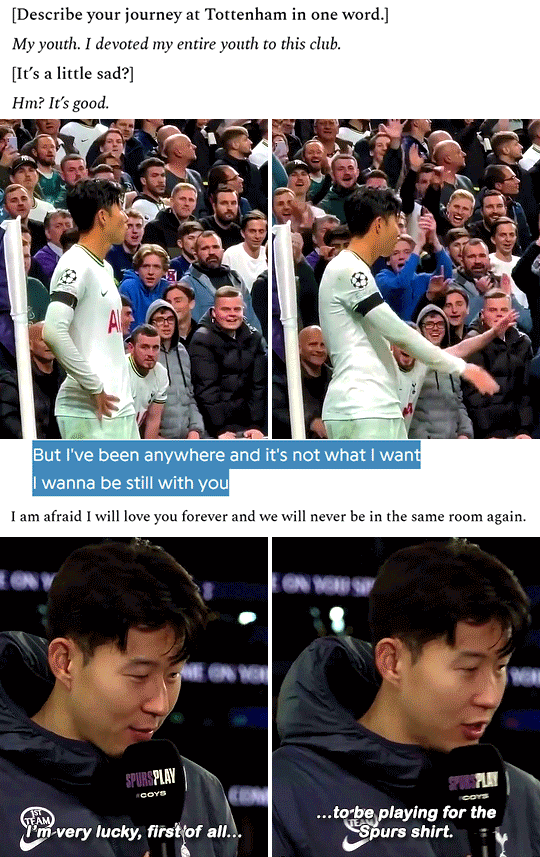






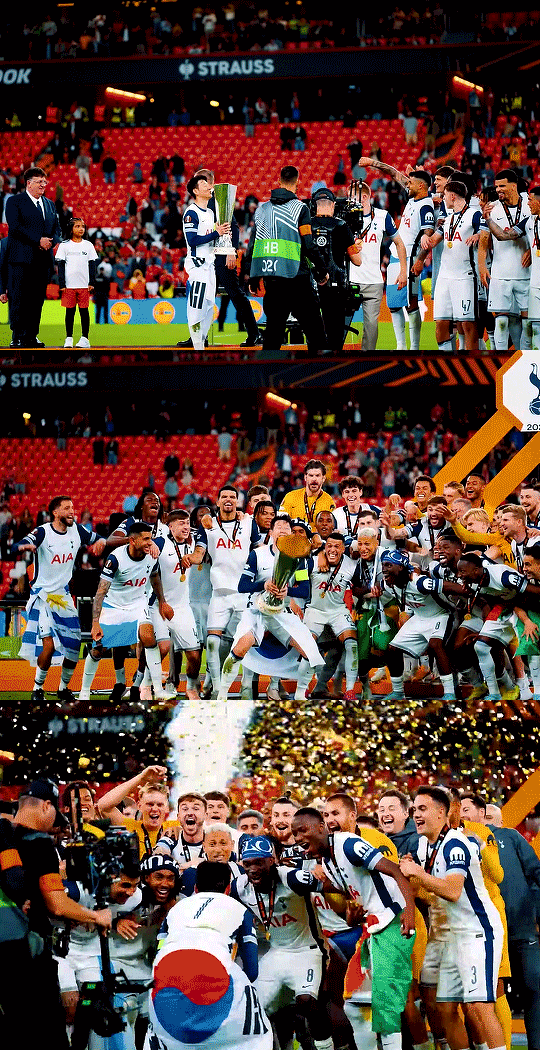



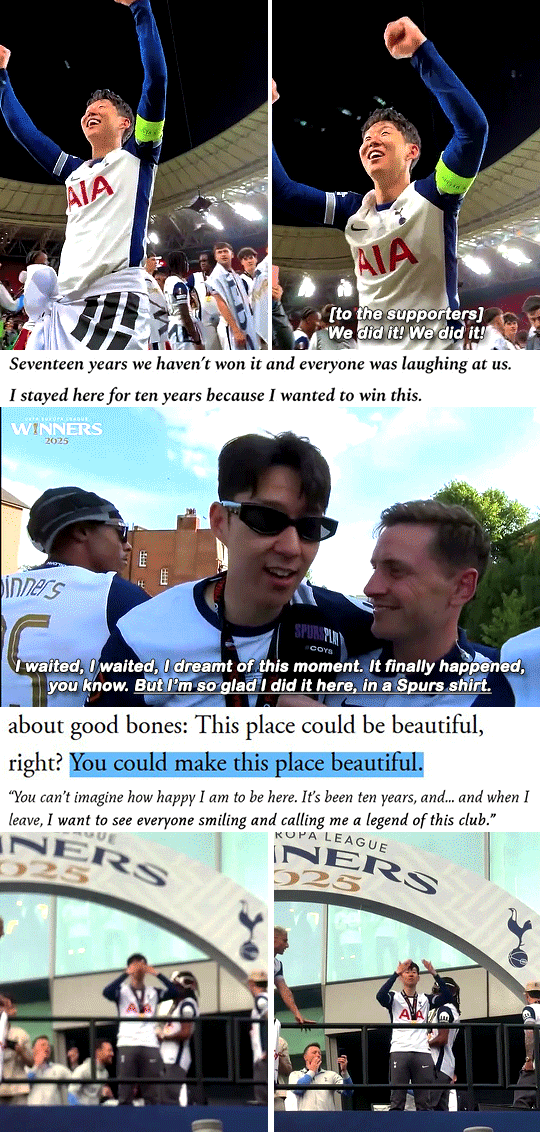
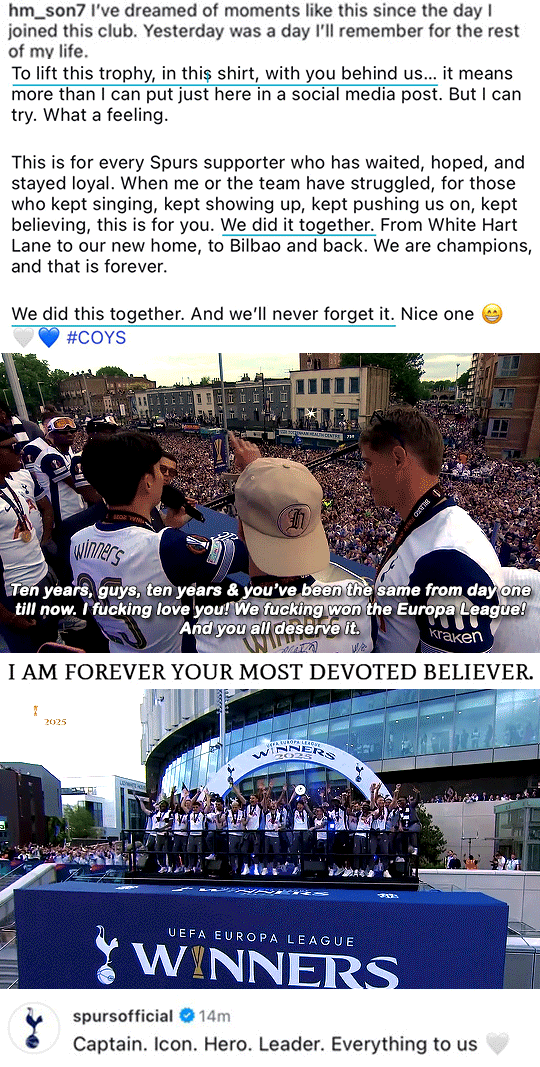
OUR BEATING HEART, THE ONE WHO STAYED. ↳ "Let's say I'm a legend."
Frederik Backman, Beartown / Son points to the Tottenham badge / BBC Sport / The Times / Son's first game at White Hart Lane, 2015 / Son talks about his career with Tottenham / Son waves to Tottenham supporters while taking a corner / Mitski, Texas Reznikoff / Clementine von Radics, In a Dream You Saw a Way to Survive / Son speaks in a post-match interview about Tottenham / Son on Instagram to Tottenham supporters after being knocked out of the Asian Cup / Lord of the Rings / Lucky Numbers / Son points to the Tottenham badge / Noah Kahan, All My Love / Son talks to the media about watching Tottenham games while being away for Asian Cup duties / Son on his contract extension / Sue Zhao / Son on his captaincy / Son celebrates with Jamie Donley and Alfie Dorrington, Tottenham academy boys / Tottenham academy boy Mikey Moore celebrates a goal with the Son camera celebration / Adam Silvera, They Both Die at the End / Tottenham players describe Sonny in one word / Son and Porro celebrate with the camera celebration / Vicario's message to Son after Son's 400 appearances for Tottenham Hotspur / Haruki Murakami, Norwegian Wood / Son makes a heart at his Tottenham boys waiting to receive the Man of the Match award in the preseason friendly against Vissel Kobe, 2024 / Alfie Dorrington on his professional debut / Brennan Johnson on Son / Mikey Moore on Twitter / Son's Instagram post after the Europa League tie against IF Elfsborg, wherein three academy boys scored, 2025 / Florence + The Machine, No Choir / Mackenzie Finklea, Beyond the Halls: An Insider Guide's to Loving Museums / Son talks about his legacy in a matchday programme / Son in a post-match interview / Mitski, Remember My Name / Son on winning something with Tottenham / Lucy Dacus, Historians / Son on his legacy with Spurs / Keaton St James, Anatomy Lessons with God / Son on his Golden Boot winning game / EDEN, Nowhere Else / Oasis, Wonderwall / Son on the Europa League Final 24/25 / Gigi Perez, Sailor Song / Vicario on the Europa League Final 24/25 / Madonna, Like a Prayer / Son pats the Tottenham badge over his heart during the Europa League Final, 24/25 / Son falls to his knees and is comforted by Bentancur as the final whistle goes and Tottenham win the Europa League Final 24/25 / Fall Out Boy, The Kids Aren't Alright / A tearful Son embraces Maddison after winning the Europa League / Orpheus and Eurydice / Son lifts the Europa League trophy as captain of Tottenham Hotspur / Son speaks to the media following the Europa League win / Joanna Newsom, Emily / Stray Kids, Behind the Light / Vicario, Maddison, Van de Ven and Romero congratulate Son following their Europa League win / Maddison talks about Son lifting the trophy in Bilbao on the open bus trophy parade / Ben Haines / Rob Daly / Ange's message to Son after Son's 400th appearance for the club / @bensdavies' tags on this post / Son in front of the infamous Ledley King quote / Ruth 1:16 / Son and Moore with the Europa League trophy / Hozier, Francesca / Son on winning the Europa League with Tottenham / Robert Frost, The Road Not Taken / A Spurs supporter on Son / Leah Horlick, For Your Own Good / Son goes over to the travelling Tottenham supporters after winning the Europa League Final / Son to the media after winning the Europa League Final / Son speaks to the club on the open bus trophy parade / Maggie Smith, Good Bones / Son addresses Tottenham supporters / Son blows kisses to the Tottenham supporters after the trophy parade / Son's Instagram post following the trophy parade / Son addresses Tottenham supporters at the trophy parade / Mo Xiang Tong Zhu, Tian Guan Ci Fu / The Tottenham boys lift the trophy in North London, led by Son / Spurs on Son
#web weaving#son heungmin#tottenham#tottenham hotspur#spurs#football#spursblr - this is from me to you. this monster post has been over a year in the making. i've been collecting quotes and moments for months#now just because deep down inside me i truly believed we would give sonny a trophy someday. it isn't perfect but i hope you enjoy it <3#we've seen sonny come in as a young lad 10 years ago & we've seen him become one of the best players in world football but most importantly#we have seen him fall in love with tottenham hotspur just as we all have & we have seen his unwavering loyalty and faith in this club grow#there aren't many stories like this in top flight football anymore. enjoy it. because in the end sonny and spurs is a love story laced with#legacy and passion and belief. he will forever be one of the most loved men in tottenham's history and i hope i managed to capture the#essence of that. up the spurs <3#rahul.txt
105 notes
·
View notes
Text
Charlotte Genre Guide
My top 5 favorite/recommended albums from each of my favorite genres!
Stoner/Doom Metal
Master of Brutality by Church of Misery (2001)
Variations on a Theme by OM (2005)
Blood Lust by Uncle Acid and the Deadbeats (2011)
Soma by Windhand (2013)
Book of Rituals by Saturniidae (2023)
Dream Pop/Shoegaze
Love Songs for the Chemical Generation by Daniel Land and the Modern Painters (2009)
The Glow by Gold Celeste (2015)
Lucid Express s/t (2021)
Daydream Twins s/t (2022)
A Fusion of Two Hemispheres by Sphere (2022)
Vaporwave
无限渴望 by Virtual Dream Plaza (2016)
一人で by desert sand feels warm at night (2019)
Soul Visioning by MindSpring Memories (2021)
Dream Desert by desert sand feels warm at night (2022)
Desert Memories by desert sand feels warm at night & MindSpring Memories (2023)
Psychedelic Pop
The Satanic Satanist by Portugal. the Man (2009)
Multi-Love by Unknown Mortal Orchestra (2015)
Skiptracing by Mild High Club (2016)
Jinx by Crumb (2019)
Raw Honey by Drugdealer (2019)
Psychedelic Rock
Parachute by The Pretty Things (1970)
In the Mountain in the Cloud by Portugal. the Man (2011)
Nonagon Infinity by King Gizzard (2016)
High Visceral Pt 1 by Psychedelic Porn Crumpets (2016)
Face Stabber by Thee Oh Sees (2019)
Progressive Rock
Shine on Brightly by Procol Harum (1968)
Lizard by King Crimson (1970)
Crime of the Century by Supertramp (1974)
Hope by Klaatu (1977)
blomljud by Moon Safari (2008)
Hard Rock
Black Sabbath by Black Sabbath (1970)
The Man Who Sold the World by David Bowie (1970)
Restrictions by Cactus (1971)
Satori by Flower Travellin' Band (1971)
Pieces of Eight by Styx (1979)
Rap
Licensed to Ill by Beastie Boys (1986)
3 Feet High and Rising by De La Soul (1989)
The Low End Theory by A Tribe Called Quest (1991)
6 Feet Deep by Gravediggaz (1994)
Shade of Blue by Madlib (2003)
Funk
Hot Pants by James Brown (1971)
Fantastic Planet Soundtrack (1973)
Standing on the Verge of Getting it On by Funkadelic (1974)
Hustle With Speed by The J.B.'s (1975)
Directstep by Herbie Hancock (1979)
Jazz Rock
Chicago Transit Authority by Chicago (1969)
Aja by Steely Dan (1977)
Junta by Phish (1989)
A Thoughtful Collapse by Vathaken (2020)
Middle Hand by Tytus & The Left-Handers (2024)
Jam Band
Rhythms From a Cosmic Sky by Earthless (2007)
Summer Sessions Vol. 2 by Causa Sui (2009)
Solar Corona by The Machine (2009)
The Doomsday Machine by Electric Moon (2011)
299 by Bull of Heaven (2013)
Disco
I Remember Yesterday by Donna Summer (1977)
Dazzle by Dazzle (1979)
Hills of Katmandu by Tantra (1979)
Tako Tsubo by L' Impératrice (2021)
Chorus by Mildlife (2024)
276 notes
·
View notes
Note
Oh yeah the big pickups to work in an office job infuriate me to no end. A whole parking lot full of death machines that have never known the touch of a gravel road or hauled anything larger than a big Costco run. I have a nice lil electric hatchback tho.
the thing is, i always wanted a car. my parents took me on a lot of road trips when i was growing up (i remember a couple years before he died, my dad told me he was very proud to have shown me so much of the country when he himself had grown up poor and could only travel as far as the next job took him), so of course i have in me that quintessential American longing for The Road. in high school, i fantasized about getting into a car and disappearing into traffic, traveling to some distant corner where nobody lived and finding a situation to occupy. god help me, as a teen i bemoaned being born too late and longed for the naive vision of the 60s i'd received from my parents and pop culture and the rusted-over kitsch that dotted the remains of Route 66 (which my dad loved to talk about).
i hate car culture in part because i used to love car culture. it's a microcosm of indoctrinated American patriotism in general. they sell you on the dream, right? the freedom of travel, of expression. i wanted to be the millennial Jack Kerouac, whose work i did not actually read because i was young and dumb and drowning in dysphoria. but as i got older i saw how quickly little bumps and scratches can turn into massive financial burdens, to say nothing of cracked windshields or flat tires. then my mom died and i was given the responsibility of handling her car, a silver scion xb. i was 19, i did not have a license and had next to zero experience driving, nor had i ever had a job before. when i say "given the responsibility to handle her car" instead of "given her car," i mean that i didn't just get her car. like, i had it, i had the keys and no one was around to tell me not to drive it. but in order to get the title signed over to me, i had to go through an insane bureaucratic process of proving that my mom was dead, and that i was her kid, and that i should have the title to the car. this took months of back and forth miscommunication as dated notices were sent and bills piled up. because it wasn't just the car i got, but the debt as well. some $30,000 of it left unpaid by mom, which i was now expected to pay in her stead. my first job was working night shifts at a wal mart stocking the frozen food department, and that was the job where i rode my bike on the highway to get to work. i didn't drive because i didn't have a license, didn't have experience, was terrified of highway drivers, and knew very distinctly that if anything went wrong i'd instantly be in so much more debt (monetary and bureaucratic) than i already was. eventually my sister, a career nurse with three kids and a house, took over the car from me.
nobody understood why i didn't drive that car more. even my mom, when she was still alive, she said "when i was your age, i was dying to get out of the house." i was too! but for all that cars culturally represented freedom, in practice what they came to represent to me was the expected cost of participating in society. i was already sensitive to adults sneering at me for my perceived immaturity (the joys of being a millennial), which only compounded on learning that i didn't have a car or license, that i wasn't proactively joining Clubs or Organizations, that i wanted to pursue the arts of all things, that i wasn't Christian, etc etc etc. i never got out to see live music because i didn't have a car and didn't have money. i didn't get my first smart phone until late 2015. i spent a lot of my college years feeling alienated because i was at least two years older than everyone else (i already didn't want to go to college straight out of high school even before my mom died), still used a flip phone, and didn't have a car. which is to say i was a working class person trying to get by in a middle class institution. and i only got in because i was very good at peddling my sob story for sympathy points. FAFSA loves to finance the odd tragedy, i'm telling you (don't worry, i still had to take on a ton of student loan debt). when i expressed to family that i didn't want a car because i didn't feel safe as a driver, and felt that i shouldn't need to have a car in order to participate in society, they said "everyone feels that way at first, but you just have to get over it. or move to a big city. good luck affording that!" as a related aside, when i told those same people that i liked being in college for the pursuit of knowledge and wanted to graduate towards being a sort of generalist, they flatly insisted that that's not how college works anymore, and that i should instead put my energies towards a Useful Degree that would Get Me A Good Job.
of course they were sympathetic, at least on the surface. they told me these things in a kind tone, the way adults always do when what they're saying boils down to "it's not fair, but life ain't fair." and i've just never been able to accept that. before i knew anything about socialism or communism or materialist dialectics, when i was still very much under the thrall of post-Clinton liberalism, i still felt this deep-rooted conviction that when people said "life isn't fair," they were giving up something. that it was an excuse, an appeal to a higher power, a resignation to the status quo. my experience with cars, by the time i hit 25, was that you bought them for the freedom they promised, and then spent of your life driving that car between one of maybe five locations on the regular and doing very little else. the only time i ever felt free in a car was on a road trip, which happened with vanishing irregularity as all the associated costs skyrocketed in the 2000s. all the other time was spent driving in circles looking for parking, only to balk at how expensive it was. spent stuck in traffic for hours, amid concrete dunes of overpasses tangled with one another like a four-year-old's first try at tying their own shoes. spent angrily judging the poor driving conduct of other people, spent resenting anyone and everyone who inconvenienced their drive, spent rubbernecking at horrific accidents on the side of the road, spent worrying about car payments and insurance payments and how much it's gonna cost to get a tune-up, and then someone breaks in and steals all your stuff and your insurance doesn't want to pay for it, and then you get into an accident and you spend months haggling with your insurance and their insurance in the hopes that someone will maybe pay for the debt you've had to take on in getting your car repaired, because of course professional life doesn't take a break just because your mode of transportation got totaled.
and if i was applying for a job and the employer found out i didn't have a car, i was denied on the spot. i learned very quickly to lie about such things as often as possible. but i also learned that i could only bluff for so long before the lack of a car became a genuinely insurmountable hurdle. which fucked me up tremendously because at no point in my adult life, to this day, can i ever imagine being able to afford all the associated costs of having a car. in many respects, not having a car was the only reason i was able to survive the way i did. it meant i could work part-time while i was in school (with student loans making up the shortfall), share an apartment with two or three or four other people, and just barely have enough to eat the bare minimum and go see a movie sometimes. of course i wanted the freedom all my car-owning friends had, but mostly i wanted it so i could drive out into the middle of nowhere at night and be truly alone. i wanted a car so that i could escape from the frictional sandpaper bureaucracy of american existence... and i knew from experience by then that that's simply not how the world works.
it took me until 2020 to finally move to seattle, one of those mythical Big Cities with Actually Existing Public Transit. and holy shit, it's a revelation! i have better access the place where i live now than i ever have, and it's a freedom that costs SO MUCH LESS than the same would've cost me back home. but i've also lived here long enough now to see all the ways in which our transit system here is deeply flawed and run by the wrong people. i see many of the same forces at play here as i did back home. i see now how car owners and allies to the car dealership fiefdoms of the nation utilize car ownership and road maintenance as a tremendous lever of power. they've deliberately trapped us in this cycle of poverty and personal transportation reliance, and used the money they got from us buying their cars to then buy politicians so that they defund public transit and oppose any urbanist reforms. did you know that much of america used to be covered by street cars and rail lines? if you live in the midwest or on the west coast, your town very likely only exists the way it does because of mass public transit. they were necessary for bringing people into these remote places to create new markets for wealth extraction. once the population in those places was stable, and mass-produced personal vehicles became the norm, the capitalists of those areas deliberately allowed the transit networks to "go bankrupt" (ie they pretended transit is a business and not a utility that pretty much by definition can't turn a profit in a traditional manner) so they could be bought up and liquidated by future car dealers. this is what i think of when i remember my family telling me "that's just not the way the world works."
why? it used to be the way the world worked. why can't it be again? if the current status quo is the result of choices that created economic pressures which shaped the nature of society, why can't we do the same thing again but different? the way things are now is sick. it's unhealthy. the vast majority of microplastics come from car rubber, and what socioeconomic classes do you think are mostly likely to live close to high-traffic roads? it's not rich people, i'll tell you that. it's not the car dealers or the small city councils worried that a bus connection might bring the poors in. when i say "car owners need to be oppressed" i'm talking about these people. suburban supremacist dictators and their sycophantic liege lords whose biggest priorities in life are to keep gas prices low and to maintain their god-given right to never having to see a poor person. i hate these people because i've been sneered at by them my whole life, while they have been personally responsible for many of the same socioeconomic conditions which resulted in the deaths of both my parents, along with many other members of my extended family. i've long since stopped believing in the idea of "death by natural causes." only the rich live long enough to die old. the rest of us die by a thousand cuts borne of neglect. our healthcare is gatekept, our education is gatekept, our transportation is gatekept. freedom is a thing to be bought, and when you don't have money, the next best thing is your blood. you give it up for a piece of something and you convince yourself that it's enough for you. but it is only a piece, and its apportionment is the result of greed and avarice happening in broad daylight all around us. i fully believe that a genuine war will need to be waged against the car barons before this horrendous now can be toppled, and it will be a war because they are aligned with the cops and with capital. this, too, is a microcosm, and in it we see the nature of our struggle for socialism unburdened by neoliberal word salad.
people have made the world this way. and people will make it something else.
#sarahposts#car culture#public transit#capitalism#late stage capitalism#classism#sorry this one got a little personal#you know me
55 notes
·
View notes
Text
Oops all Women! for Terror (2018) playlists
I'm still reeling from today's 2 Hickey playlists and in honor of that here are the ladies of the Terror! Plus Tuunbaq! <3 I really have been enjoying making each one of these ones & I didn't think I'd make a tuunbaq one but that one came together almost like a dream. I must thank all of those who have allowed me to bounce ideas off of them and generally for anyone who listens to the playlists or looks at the post. <3 I love this event so much, it truly is every Sunday a dream come true.
Silna [LINK]
ataataga by Riit || Immutaa by Beatrice Deer || Deeper Than Love by Colleen Green || Embody by Frankie Cosmos || Waniska by Kym Gouchie || OK Indicts by Leanne Betasamosake Simpson || Gravity by The Blasting Company || Easy by Thao & The Get Down Stay Down || Tuttukasik (Bonus Track) by Nive Nielsen & The Deer Children || Don't Touch by Norma Tanega || Someday We'll Linger In The Sun by Gaelynn Lea || Tuattiaq by Joey Ammaq & Terry Uyarak || Happy Phantom- 2015 Remaster by Tori Amos || Beautiful Mother by Dirty Projectors, Bjork || Ghosts in My Heart by Mariee Sioux || Breaking Down by Florence + The Machine || House of Spirits by The Veils || House of 1982 Built Like A Ship by Driftless Pony Club || Words That Stay by Tele Novella || Ghost of a Boy by Rae Spoon
Tuunbaq [Link]
Song For A Dying Planet by Joe Walsh || The Planets Op. 32 VII. Neptune, The Mystic by Gustav Holst || Last Morning Watch IV. by Marcus Fjellström || Uninhabitable Earth, Paragraph One by Dirty Projectors, David Longstreth, stargaze || Nekton by Cosmo Sheldrake || Nocturne for Bassoon and Marimba by Connor Chee, Jacqueline Wilson, Christopher Wilson || Pollution by Tom Lehrer || Winter Saltings by Laura Cannell || Polar Sirens by David Bickley and Tom Green || Coyote, My Little Brother by Pete Seeger || Buzz Run by Heloise Tunstall-Behrens & Auclair || Sea Organ by Wonderfulsound || Better by The Honeysticks, Ricky Montgomery || The Firebird Suite (1919 Version): The Firebird and its Dances- 2017 Remastered Version by Igor Stravinsky, Leonard Bernstein, New York Philharmonic Orchestra || Pohjanpalo- Polar Night by Tuuletar || Normalization Blues- demo by AJJ || Pandemonium by Silla and Rise || Wolf Quartet - Original Mix by Matt Berry || All Fell Down by Jason Steele || Birth of Liquid Pleades by Tangerine Dream
Lady Jane Franklin [LINK]
Girls Just Want To Have Fun by Cyndi Lauper || Water Me Down by Vagabon || Queen of the Night Aria (Der Holle Rache) by Mozart || 3 O'Clock Things by AJR || Just LIke Jesse James by Cher || Kokomo by The Beach Boys || End of the Party by The English Beat || Leather and Lace- 2016 Remaster by Stevie Nicks, Don Henley || Don't Stop Me Now by Queen || Honky Cat- Remastered 2017 by Elton John || I Feel So Good by Jukebox the Ghost || Keep on Loving You by REO Speedwagon || Hole In My Pocket by Sheryl Crow || Anything You Can Do by Bernadette Peters, Tom Wopat || Night Waltz by Terry Trotter || Dancing in The Moonlight by King Harvest || Turn The Light by Karen 0, Danger Mouse || Everything's Coming Up Roses- Remastered Version by Linda Kirk || Anything Goes by Patti LuPone || I Still Believe by Tim Cappello
Sophia Cracroft [LINK]
Being In Love by Wet Leg || Sophisticated Girl by The Pezheads || Only You Know by Dion || Manhattan by Cat Power || You and I by Caribou || Hunter by Becca Mancari || Strawberry Jam by FIZZ || Dog Days Are Over by Florence + The Machine || You Shadow by Sharon Van Etten || Everything Now by Arcade Fire || Slip Away by Perfume Genius || Big Time Nothing by St. Vincent || Kyoto by Phoebe Bridgers || Ich küss dich tot by Schnipo Schranke || Burn Your Life Down by Tegan and Sara || Angel! Wild! Superstar! by Ha Vay || Lily by Mamiko Suzuki, Rachel || Strawberries by Asobi Seksu || Your Dog by Soccer Mommy || Deep Sea by Snail Mail
#terror playlist heaven or hell#sophia cracroft#lady jane franklin#jane franklin#silna#the terror#davechella
36 notes
·
View notes
Note
"Can you recommend a fanfic where the characters are closer to their versions in the series? For example, I saw someone write that they are writing a fanfic where Gi-hun is much closer to his version in the series."
Apologies for the delay. This question really stumped me, if I’m honest ;-; Mostly because I don’t know what “closer” means. I think there’s many different interpretations we can have based off canon. Here’s some I like from a canon-compliant character study lense:
lighter fic:
> Protective Measures by faintneko
Outsider POV from Sae-byeok’s perspective. No Squid Games AU, but the adjustments are accurate. The character voice is very strong in this one.
> this morning, this evening, so soon by layoyo
A what-if story exploring if Gi-hun got on the plane. I love stories that feel like gentle rain, and this one I think is one of them. It follows Gi-hun very closely in the process of grief and healing, and In-ho here is very much a “reaching out to you and hope you take my hand” version.
> When Will You Return + Sequel by Lust4Wife
This premise of this story is what if Gi-hun had never entered the games and met Il-nam before he passed, only to be left a small bit of inheritance. If you want a fic that feels like S1 Inhun, this is a very strong contender. I will note it’s in mandarin (I used google translate to read it), though it has an English translation. I still prefer the mandarin one. I think the English version was written to sound “perfect” to natives but it sacrificed a bit of the nuance.
> One Rainy Night In Seoul by hl14
A canon-divergent fic in which a 2015 In-ho meets Gi-hun before he becomes the Frontman, and it changes his life. hl14 is an authors whose body of work I think exemplifies the different ways In-ho and Gi-hun can be interpreted while still feeling like their canon selves.
> in other words, please be true by songxiong
This fic is a fascinating one in that it has the same premise with the opposite take: In-ho meets Gi-hun before he becomes the Frontman – and it finalizes his decision to become him. One of the earlier fics I read in the fandom and it really helped refine my perception of In-ho’s possible motivations.
> Сyclicity by Dragira_Dje
Canon AU in which every time Gi-hun dies he gets a redo, but he still joins the games. Magical realism take on canon essentially (and I know I’m cheating a little with this one). I particularly really liked the character voice. It felt very much like Gi-hun.
> The Life and Times of Worker 456 by Nite_Rose
A fic in which Gi-hun is a worker instead of a player. Based on the premise, it might not sound like a character study but I think it can definitely be seen an exploration of how different choices could lead to different outcomes, while still staying true to Gi-hun.
darker fic (heed the tags):
> i don't dream of unicorns by ha1lmary
A post-season 2 fic. We get really in Gi-hun’s head for this one and it’s just about as heart-wrenching as the first time I watched the finale. You really see Gi-hun fall apart. Which you know, is my cup of tea.
> sheepskin by throwafit
Explores the premise of “what-if Gi-hun chose to get on the plane” as well but it’s a different interpretation than this morning, this evening. In this one, In-ho’s machinations are more intense, and I think you it really emphasizes Gi-hun’s loneliness.
> Ghost of the Longing by Beb
An In-ho POV fic where he pretends to be a ghost to haunt Gi-hun after his “death.” In-ho feels very keen and spider-y in this one if it makes sense. I do so love the wolf-among-the-sheep character exploration of him.
> i'm your man series by gaycultivators
Canon-adjacent fic in which In-ho pretends to have sex somnia in order to have his way with Gi-hun. I think it plays well with the tension of what we know as an audience and what Gi-hun knows, and particularly enjoyed how it portrays In-ho’s brand of manipulation.
> Take the Bait by crankyLilah
Intense character study of In-ho’s POV from season 1 to the present. The undercurrent of obsession and delusion is impeccably interwoven into the events. It’s just poetry, really.
~ * ~
Anyway, I have 100+ bookmarks so I can be here all day. I mean just based on canon-adjacent character studies only I had to exclude a abo fics, historical, fantasy (please ask me for fantasy recs ;-;) etc since characters are affected by the world they live in. If you enjoy any of these, please remember to give the authors their flowers 💐
#squid game#inhun#457#001 x 456#ginho#fic recs#ask box#anon ask#my thoughts#not even eight hours have passed and I’m already thinking of more fics I should have added to this list
42 notes
·
View notes
Text
No Mercy, Episode 1: Americans could not handle this.

Today, we begin our deep dive into K-pop band assembly shows. We are starting with No Mercy, which ran from December 2014 to February 2015 and brought us Monsta X, one of my favorite groups. The first episode is called “The Cruel Debut War Gets Started.” And right off the bat, after seeing just the first episode, I realized I needed an attitude adjustment when it comes to these shows.
I thought calling No Mercy a survival reality show was a bit overdramatic before I actually started watching it. I was seeing the concept through American eyes. While losing an American survival reality show can mean death in the wilderness, I now know that losing No Mercy means death of your dreams and your pride, not to mention the realization that you have sacrificed years of your life being a trainee in the K-pop system, only to be eliminated.
Honestly, if I had exceptional musical talent and was given the choice of competing on either Korea’s No Mercy or America’s Alone, I’d take my chances in the wilderness of Northern Mongolia for the American show. Being crushed by falling boulders is preferable to having my soul crushed and then being shown the door. Losing the American show means you only die once.
Yes, it is that serious.
Just to provide some context, K-pop idols spend years as trainees, hoping for a chance to debut. They train from morning until late at night, taking lessons in dancing, singing, rapping, and acting, as well as interviewing, songwriting, production, and other practical skills. They can spend up to ten years of their lives as trainees, getting very few days off and working themselves to exhaustion. In the end, only a very small percentage of them will debut. And even if they do debut, there’s no guarantee that they will catch fire with the public and become famous and successful.
Landing a spot on a Korean survival reality show is the chance of a lifetime for these trainees. On No Mercy, there are only twelve spots. Which is why the rankings are so important. Making it on the show is just the first step. If you get ranked last on the very first episode, it’s considered a failure, even though you don’t get cut in the first rankings. Never mind the fact that it’s an incredible accomplishment to get on the show in the first place. The trainees don’t see that. All that matters is the debut.
If you rank dead last, even if you don’t get cut from the show right then, it means that there are eleven people between you and the debut, and only the top few will get chosen. In other words, you may as well be back in the dorms, still anonymous, getting ready for another 14-hour day of gruelingly relentless dance practice.
No Mercy only ran for one season, and I already know who the winners are. That does not spoil the show for me in the least. Just from the first episode, I’m seeing the band members in a whole different light, and I’m also learning way more about the K-pop machine and how cruel it can be to someone with a dream.
Take Shownu, for example. He’s currently the leader of Monsta X, so I know he’ll make it, but this first episode shows me what he’s been through just to compete on this show. The show focuses mostly on him for right now, and we open with the initial rankings. We only see a few seconds of their initial performances in a small room in front of the judges, and right away, Shownu gets the top spot.

If this were an American show, two things would happen here.
We wouldn’t be told the top spot first. They would start with the last spot and build up to the top two spots, with the remaining two trainees clutching each other and freaking out. In fact, naming the number one spot right away seems anticlimactic. But there’s a reason the first spot gets named first, and it’s spelled out in Shownu’s reaction. He is somber. He quietly and calmly walks over to the judges’ table to accept his first-place badge and bows to them. The reason for this reaction is Difference Number Two:
Getting ranked first isn’t just an honor for Shownu. It’s a weight on his shoulders. Out of all the trainees, he now has to spend the rest of the competition trying to prove that he’s worthy of that number one spot. He also has eleven other trainees now gunning for him. The man does not crack a smile once, not even the moment when the judges say his name. For us, the suspense isn’t finding out who got the first slot. It’s finding out the order of the other trainees, whose rankings now indicate how badly each one wants to trip Shownu on the stairs.

Knowing how this is all going to play out, I’m surprised to see how low some of the eventual winners rank in this first round. While Jooheon and Wonho rank #2 and #4, respectively, Kihyun, Hyungwon, and Minhyuk come in at #8, #9, and #10. Kihyun’s relatively low ranking really surprises me, because he is now known for having one of the most amazing singing voices in the industry. We don’t get to see him or the other singers audition for these rankings, so the competition must have been insane.
The trainees then split up to work with different industry experts, who are helping each one prepare a three-minute performance for the next round of rankings. Emotionally, the process is run like a military boot camp. From here on out, the trainees are referred to by their numbers, not their names. The trainee named Yoosu, who is ranked last, is called “Number Twelve” during this process, a constant reminder of his failure. It’s not much better for Shownu to be referred to by “Number One,” considering it’s a constant reminder to watch his back. They may as well call him “Target.”
The experts working with them can be worse than Simon Cowell with severe hemorrhoids. Here is a partial transcript of one expert’s rap lesson with four of the trainees:
Expert: I have to call you by your numbers. #7: Here, too? Expert: Yes, at all times. #2: So I’m Number Two, and not Jooheon? Expert: Yes, you’re Trainee Number Two. #5: I’m 5-Yoonho. (laughs) Expert: (stone faced) I want to call you Number Twelve. You have to do better from now on.

#7: I tried to think of it as Lucky Seven. Expert: Don’t give me that. You’re number twelve in rapping.
This is not friendly banter. The expert looks like a fed-up high school teacher who just caught four students cooking meth in the chem lab. If any of the contestants on The Voice or American Idol faced this expert, they would sue the network.

All four trainees now take turns rapping for the expert, and despite the show’s title, putting Jooheon last is an act of mercy. None of the other trainees should have to follow his performance. If Kihyun is known for his singing voice, Jooheon is arguably the best rapper in K-pop. His lyrics in the Monsta X song “Gambler” and the cocky way he delivers them is one of my favorite musical moments, period. (“ME? I’m a handsome sum of moNEY, I got a vesper marTINI...”)
So I am excited to see young trainee Jooheon perform, and he does not disappoint. At least for the few seconds we get to see. The expert cuts him off after just a few lines and begrudgingly says, “Okay, that wasn’t too bad,” and even though that is this expert’s verbal equivalent of giving Jooheon a Billboard Music Award, I still want to smack him upside the head with his own clipboard. YOU do not tell Jooheon when to stop rapping. HE decides when he’s done.

We then switch over to the vocalists in their session, and this expert is a bit more encouraging. Again, we only get snippets of each performance, but we do get to hear Kihyun. His singing takes my breath away. I don’t see how he’s ranked at Number Eight, unless he really bombed in the first round. I’d love to see him do a rock opera.
Now we get to a segment on Shownu alone, and this is the part that really made me see him and what he’s been through. We learn that he used to be a trainee in a different entertainment company called JYP Entertainment. (No Mercy is run by Starship Entertainment and features their own trainees.) During his two-year stint at JYP, he trained with a group called GOT7. Instead of debuting with the group, Shownu was cut. He was twenty years old at the time. GOT7 went on to become very famous, touring several times and winning many worldwide music awards.
He's still friends with GOT7. No Mercy cuts away to follow him as he waits for them outside a venue. After their performance, they come out and embrace their old friend. They go to dinner, and right away, even though we feel their chemistry as friends, Shownu is still a million miles apart from them.
GOT7 talk about how surprised and upset they were when Shownu left JYP. Shownu looks sad. He says he’s used to seeing everyone around him go on to debut. The emotional gut punch actually brings tears to my eyes. In a confessional clip, Shownu says that the pressure got to him at JYP, and he couldn’t take it anymore. Later on, he says that every time he sees his GOT7 friends, he feels pathetic.
The show’s title isn’t just about what the trainees go through. This program shows no mercy for the viewers’ emotions. This is heartbreaking.
GOT7 and Shownu leave the restaurant, and as they walk down the street, fans gather to take pictures. Shownu steps back a bit so he doesn’t get in the way of the cameras. In the confessional cutaways, he’s pragmatic about it, but he’s clearly uncomfortable in the actual situation.

As they part ways, he hugs his friends goodbye, and the fans temporarily stop taking pictures, waiting for the unknown guy to get out of the way. He stands alone in the street and watches them walk away, trailed by their adoring fans.

I hate this show for doing this to me. If I were still drinking, I’d be typing this from inside a bottle of Barcardi right now. My only consolation is knowing Shownu is going to make it. Most trainees don’t get a debut or any kind of happy ending. Shownu is going to be one of the lucky ones.
Back to the competition. I never thought I’d be so happy to see the grumpy experts from hell again. We have arrived at D-Day 1. Our trainees will perform on a concert stage for the original judges and some new ones who are actual K-pop idols. Jooheon is excited. He wants Shownu’s spot.
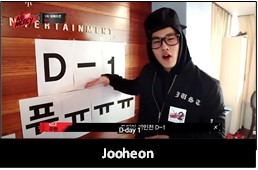
The trainees are driven to the venue. They are all nervous, except for Jooheon. He is confident. He is ready. I love him so much. Sorry. That was unprofessional. Where was I? Right. D-Day 1.
The trainees line up on the huge stage. Only the stage is lit up. The seats are shrouded in darkness. As the trainees stand there, trying to control the jitters, a spotlight suddenly beams onto the judges’ table. They have been sitting there in darkness, waiting to ambush these poor trainees like angry parents waiting for a teen who is way past his curfew.
But that’s not enough. Large cubes suddenly light up in front of the stage, showing the numbers one through twelve. The trainees have to go stand behind their numbers. I actually wrote “psychological warfare” in my notes. This show isn’t just trying to rattle these trainees. They want the weakest ones to just collapse and be dragged offstage to save the judges having to vote them off.

Honestly, they should just give each trainee a cyanide pill and a shot of tequila. Then they could at least go out with some dignity.
Except for Jooheon. He’s got his game face on. He looks ready to take a bite out of the stage and spit out the splinters.
Shownu is up first, and I can’t believe we’re only 26 minutes into this show. I have already been through the emotional wringer and taken six pages of notes. I don’t know how much more of this I can take.
Shownu takes the stage while the other trainees wait backstage, and right off the goddamn bat, one of the judges says, “When I first met you, I didn’t think you were Number One material, but look at you now.” He is not giving a compliment. His tone of voice implies that Shownu got away with something. And Shownu, to his enormous credit, simply says, “I must have gotten lucky at the first evaluation.” If that had been an American contestant, there would have been hands thrown.
The judges also bring up that Shownu was cut from JYP after two years, and I wrote in my notes, “WHY ARE THEY DOING THIS??!!”
But our guy pulls himself together and sings a lovely rendition of John Legend’s “All of Me.” Then he shows off his skills in a dance routine that foreshadows the incredible precision moves we’ll be seeing in a couple of years.
The judges clap. Their attitude is reserved, but they liked the performance. One of the judges who knew him when he was at JYP says she didn’t know he could sing so well.
Shownu bows in gratitude. I stress-eat an entire box of Belvita biscuits.
Next up: Jooheon. We get a confessional clip in which he says he wants to become such a good rapper, he will drive people crazy. Again, I think of his performance in “Gambler” and get chills.
He begins, and the lighting crew does not let him down.

The song is mysterious, chilling, aggressive. Jooheon moves like the song has possessed him. The judges are mesmerized. The other trainees backstage are mesmerized. I’m mesmerized.

After the performance, the judges tell him that his performance is already at a professional level. All I can think is, wait until you see him in a couple of years.
Backstage, Shownu says Jooheon did well, and we can see he’s concerned. All the trainees are concerned. They can hear the judges showering praise on Jooheon. Considering that a few of these judges have a default setting of “you suck,” they have every reason to be worried.
After Jooheon leaves the stage, the female judge, who I think is a K-pop Idol herself, says, “He scares me when he raps. He’s scary. The way he looks at me.” Again, check him out when Monsta X is on tour. He can be dangerous.
We’re getting close to the end of the episode, and No Mercy knows how to end on a cliffhanger, although this is an even more effective one for viewers like me who already know the outcome. Our next trainee is Hyungwon, another eventual winner.
As a fan of the group that’s being formed, I’ve always found Hyungwon to be an enigma. He’s stunningly handsome and has a cool, quiet vibe about him, yet the fans also love him for his clumsy, adorkable personality and how he’s often the butt of the jokes in the band. For now, the handsome and cool vibe is on full display, and it’s having an obvious effect on the female judge.

I am on the edge of my seat for this. If you’ll remember, Hyungwon is currently one of the lowest ranked members, at Number 9. The reason for his low ranking is because the judges only remembered how handsome he is, but nothing about his singing or dancing stood out to them.
We the viewers didn’t get to see any part of his performance during the initial rankings. But fans like me know what Hyungwon is capable of. His solo stages during Monsta X concerts are some of my favorite moments of the shows, especially when he performed “Wildfire” on the band’s No Limit Tour in 2022.

“Wildfire” has always been a fan favorite from this tour, and it’s not just because of Hyungwon’s good looks. He could be wearing a paper bag over his head, and his dancing, combined with the set design, still would still have the audience enthralled. (His singing would be a bit muffled.) While I do understand the judges getting distracted by how handsome he is, I want them to see more.
The judges settle in. Hyungwon lifts his microphone. And then, No Mercy kicks us in the metaphorical balls by ending the episode.
Audiences at the time this show was being aired would have to wait another week. Because No Mercy is cruel. No Mercy is a bully. No Mercy is the Korean equivalent of Eric Carmen giving us amazing songs that lift our spirits while simultaneously calling us libtards on Twitter.
And I will be watching and recapping every single episode.
Stay tuned.
31 notes
·
View notes
Video
Analysis by Thomas Hawk
#America#Bay Area#California#Coronet 500#Dodge#Dream Machines#Dream Machines 2015#HMB#Half Moon Bay#Northern California#SF#SF Bay Area#USA#United States#United States of America#West Coast#auto#automobile#car#emblem#norcal#flickr
3 notes
·
View notes
Text
Saturday Morning Vid Recs - Space and Robots
@tafkarfanfic asked me for vid recs that are similar to the following vids:
Data’s Dream by GayleF (Gayle) and TasheryS which premiered at Escapade in 1994 - made on a VCR!! - and was remastered by morgandawn in 2004. Definitely check out the Fanlore page about Data’s Dream. Star Trek + multi-source.
Starships by bironic. Multi-source. The history of Starships on Fanlore.
These two vids are iconic. Please check them out and learn about their history from the Fanlore page, it's a great look at some vidding history and culture. Amazing vids, do love. As for some recs. I love this kind of prompt. More vids like [this vid] is so much fun. I dug deep into my vid rec archives and brain and bookmarks. I’ve also crowdsourced some recs from the vidding discord. Thank you to @rukbat3, @sandalwoodbox, @fairestcat, @monkeyswithjetpacks, @grammarwoman for the reccing help! And everyone else I might have forgotten.
From Land to Sky - and kicking ass while you're there!
Landsailor by @singlecrow/raven. Multi-source. Swades (We, The People); Master and Commander; 3 Idiots; The Dish; The West Wing; Parks and Recreation; Flight of the Phoenix; NASA archive footage; Apollo 13. ❤️ We're gonna need a bigger boat. Come O’ Eclipse by melodytree. Tenchi: The Samurai Astronomer. Calendar-making! Math puzzles! Astronomy! Politics! Eclipses! Oh my! Galaxyrise by starlady. Multi-source. Apollo 13 (1995), Interstellar (2014), Gravity (2013), Europa Report (2013), Contact (1997), The Martian (2015). This vid is full of so much wonder! The sky calls to us/If we do not destroy ourselves/We will one day venture to the stars. Going through space with the world by bironic. Space Exploration RPF. ❤️❤️❤️ From "day in the life of an astronaut" videos to international stardom; or, Chris Hadfield and his adorable mustache. Monsters of the Cosmos by CherryIce. Thor/MCU. Jane Foster/Science.Cherry’s editing is goddamn incredible. In the last century, black holes have gone from being mathematical curiosities to real objects in the cosmos. This is a vid about Jane Foster and her one true love, Science. Also, Thor is there. Toxic by JinkyO. The Planets (TV - 2019). Humanity/The Solar System. This vid is so fucking brilliant and makes me cackle in love and awe so much. It's dangerous, I'm loving it. Sci-Fi Friday in a Blender by Luminosity. Multi-source. Farscape, Battlestar Galactica and Doctor Who. So much happening in this vid. This is among one of the earliest vids I remember watching and became obsessed with back in the day. Supernova Girl by @usuallyhats. Multifandom. Doctor Who, Star Wars, Babylon 5, Steven Universe, Andromeda, Farscape, Battlestar Galactica, Firefly, Mass Effect, Stargate. So many wonderful brilliant amazing EXCELLENT supernova women and girls. Zoom, zoom, zoom. Space Girl by @aurumcalendula. Multi-source scifi. Inspired by Charmax’s Space Girl vid and Bironic’s The Greatest. This vid has a great selection of newer tv shows and films and it’s fun to play spot that character. But also this vid will grab you by the heart, too. Utterly brilliant, perfection. A must watch!! 'I've been as far in hyperspace as anybody can.' One Girl Revolution by bessyboo. Star Wars, original and prequel. Padme and Leia!! Seeing these two focused on in one Star Wars vid is an adventurous kickass ride. I'll be everything that I want to be. Space Girl by charmax. Multi-source scifi. One of the most beautiful epic space vids out there! I know I’ve recced this before and I’ll rec it again and again and again. My momma told me I should never watch Sci-fi but I did, I did, I did.
Robots! More than wires.
If a Machine by caramarie, Multi-source. Robot narrative focusing on machine origin, intelligence, and interaction with humanity. And Human fallibility. An incredibly rewarding watch and rewatch. This is the story of cables and copper wirings. Electric Avenue by @monkeyswithjetpacks. Multi-source robots! Nate’s multi-vids are always so fun, especially when it’s showcasing classic cinema and all these excellent serials. Electric Avenue has source from 1919 to 2015. His editing is always on fucking point. Don’t miss this vid. We’re gonna rock down to electric avenue. Everybody by @kuwdora. Star Trek, the Borg. This vid was actually inspired by the Backstreet Boys original music video. I still have the vivid memory of watching or rewatching the original music video in @ars-amatoria ’s kitchen. And then at some point realizing it is perfect for the Borg. Am I original, am I the only one? Fembots by Grammarwoman. Multi-source. Sexy sharp editing and fun use of all the sources. The intersection of women and technology: a spectrum of clones, AIs, gynoids, cyborgs, and other artificial creations. On by @rhoboat77. Star Trek: Picard. A Soji fanvid. Rho has the sharpest editing skills this side of the Internet and this Soji vid is so fucking badass and worth 100 rewatches. Can’t hold me down cuz you know I’m a fighter. Que Sera Sera by @ohvienna. Star Trek Voyager and Picard. Seven of Nine.Nobody vids their Seven of Nine love like @ohvienna. You gotta watch this if you love Seven. Whatever will be, will be…"
Journey through Space.
To Touch the Face of God by destina. Multi-source. The Right Stuff (1983, )The Dream Is Alive, From the Earth to the Moon (TV).This is one of the most beautiful moving vids you will EVER, and I mean EVER see. From Chuck Yeager, to the Mercury 7, and on to Apollo and the Space Shuttle Program (STS) - a very human history of the triumphs, joys, and tragedies of the USA's journey into space. Doctor Who on Holiday by sisabet. Farscape, Battlestar Galactica and Doctor Who. A mashup vid of Luminosity’s Sci-Fi Friday in a Blender. This vid inspired me so much. And I have 10 very intense ideas about how I would do my own remix of this vid if I were to make it right now. Fly Me To the Moon by thirdblindmouse. Multi-source. This vid has everything! Alien sex! Xenophilia! Zero-gravity sex! Mpreg!!! Because everyone knows this song is about space sex. Game Night in Space by garrideb. Multi-source. This vid!!!!! IS! SO! MUCH! FUN!! Game on! How are you going to spend those long nights on your starship? Play games, of course! Space poker, space chess, space Monopoly… this is a fanvid celebrating game night in space, set to Don't Stop Me Now by Queen. Starships (Monochromatic Remix) by @monkeyswithjetpacks. Multi-source. See the Fanlore page on the history of Starships (Monochromatic Remix). ALSO check out jetpack-monkey’s extensive notes and side-by-side comparison vid of the original vid and his vid!! He matched Starships shot-for-shot! Most brilliant work ever. The vid notes aren’t on the ao3 page so I HIGHLY recommend checking out the notes on his dreamwidth page! This vid is 10 million kinds of brilliant and technical prowess and perfection.
Vidshow Rec
Alien Invasion! - 30 vids curated and organized into a show by @tafadhali for VidUKon 2024. Featuring films and tv shows: Nope, Attack the Block, Pacific Rim, Venom, Doctor Who, Stargate Atlantis, Star Trek, Prey, Smallville, Rowswell, Supergirl, Arrival, Starship Troopers and more.
Follow these tags to keep up with vid recs this summer:
#saturday morning vid recs
#kuwdora recs
A helpful guide I wrote:
How to Leave Feedback on Fanvids
#saturday morning vid recs#kuwdora recs#vid recs for takfarfanfic#kuwdora vid recs#vid rec#vidding#fanvid#fanvideo#fanvids#fan video#fan videos#fan edit#video edit
102 notes
·
View notes
Text






























I CAN THINK OF NOTHING ELSE BUT THIS MACHINE
the beginner’s guide, 2015/the archive of alternate endings, lindsey drager/jon fosse’s search for peace, the new yorker/house of leaves, mark z. danielewski/model of new babylon, constant nieuwenhuys/ornithopter, richard siken/james watts to lind, 1765/buckminster fuller with his domed city design, 1971/the garden of forking paths, jorge luis borges/the clochán, david malloy/base of the christ steeple under construction, la sagrada familia, 2009/matilda bernstein sycamore on writing on your own terms, lithub/daily bread, ocean vuong/the rose, jay defeo/the beginners guide, 2015/how to build a table/duel with cudgels, francisco goya/solaris, stanislaw lem/into thin air, jon krakauer/dicken’s dream, robert william buss/magic show, paige lewis/the machine, lemon demon/house of leaves, mark z. danielewski/la pensée, rodin/the old catcher considers the failing of his knees, devin kelly/leaving port, ingeborg bachmann tr. mark anderson/the painting that includes all paintings, richard siken/the beginner’s guide, 2015/high to death, car seat headrest/the clochán, david malloy
#webweaving#web weaving#i need a tag for my own webweaves but idk what. whatever#really dont know what else to tag this anyone else didnt feel very well when they painted the first and didnt feel very well when#they painted the last. lol. um#first ones in here were the machine/high to death/the clochan thats like the core of it. crashes my car
22 notes
·
View notes
Text
'At the end of the novel, Chang Geng goes beyond strengthening the state to embark on a constitutional reform to secure the rights of the individual citizen. Readers rave about his punk declaration:
I hope that one day my state will be strong and liberal; my people will all be employed; my territories will be free from warfare and my generals relieved of their duty to guard the frontiers. I will untie the deadly knot between the imperial power and ziliujin. I want steam machines to cultivate the fields, air-borne ships to carry families on their journeys back home. My dream is that every human will be able to live with dignity.
我想有一天国家昌明,百姓人人有事可做,四海安定,我的将军不必 死守边关,想......解开皇权与紫流金之间的死结,想让那些地上跑的 火机都在田间地头,天上飞的长鸢中坐满了拖家带口回老家探亲的 寻常旅人......每个人都可以有尊严地. (Priest 2015)
However, the novel allows “every human,” a universalist claim that seems to transcend nationalism, to be used as an empty slogan, not bothering to demonstrate how Chang Geng would treat the “barbarians,” his own people on the maternal side of his family. On the one hand, the novel, ostensibly a Confucian jiaohua story (that is, a story of transformation of the self and others through education), embraces cultural universalism and celebrates Chang Geng’s assimilation into Han civilization via homosexual desire. In other words, it enacts a Chinese version of homonationalism and celebrates [the nation's] openness toward the noble (and gay) barbarian who is even allowed to grow into a sage emperor. On the other hand, it portrays the Liang Empire, before its final victory over the European other, as suppressing labor insurgency caused by automation within its national boundaries and imposing unequal treaties on the northern and western barbarians, turning them into semicolonies. There is a fracture between the glorified notion of “every human” and those expendable bodies whose exclusion is the foundation of the unity of the nation. Inspired by reader discussion, I raise these questions: how to legitimize Liang’s invasion of barbarian lands when the European invasion of Liang is condemned? Where is the rebellious worker located in Chang Geng’s dreamland?'
-"Steampunk, Zombie Apocalypse, and Homoerotic Romance," Zhange Ni
#danmei#stars of chaos#sha po lang#haven't read sha po lang but this sure is an interesting critique guess I'll have to read the book now if only just for academic purposes
16 notes
·
View notes
Text























Dallas Seavey at the Ceremonial Start and ReStart of Iditarod 52. Dallas. Seavey. The kid that believed he was on a trajectory for an Olympic career and not a dog mushing one. Oh, sure, he was like many others of his generation who not only grew up in the presence of many great mushers - all the while helping his dad build a successful racing kennel - but one who watched Iron Will and tried to recreate many of the scenes from the movie... but as he often told tourists - he had no desire to make it his life like his dad had.
Then injuries sidelined his Olympic wrestling dream (was on his way to making the 2008 USA team) so he came home and continued helping his dad build monster teams.
After a while running the puppy team just wasn't enough. Puppy teams are competitive and if you know Dallas even a little bit you know the dude is extremely competitive.
He studied like he was working on a Masters Degree. No one knows the science and stats of the race more than Dallas. Guarantee it.
He won his first title in 2012, then again in 2014, 2015, 2016... took a break after his second place finish in 2017 (we won't rehash the whys) and came back in 2021 to win it again (granted the shorter "Gold Loop Trail" - thanks Covid - but he battled the Rainy Pass Pony Mafia so it still is a huge accomplishment). His '21 race meant he tied for most wins, sharing that record with the legendary Rick Swenson. Swenson was one of Dallas's childhood heroes... and Dallas had broken or tied just about every record Rick had.
This year, Dallas won number six. He is the winningest Iditarod Champion.
It wasn't easy. In November he and two of his handlers took teams out on a training run. His handler running many of Dallas's top dogs was hit by a snow machine. Dogs were killed, some injured with career ending, life altering injuries. The mushers were physically all fine, but mentally... mentally it took a while to feel "normal" on the runners.
Dallas borrowed dogs from his dad to make a competitive Iditarod team, it wasn't ideal - but he'd done it before. The Ceremonial Start and ReStart seemed to go on without an issue. Crowds cheered the musher on and he quickly slipped into the routine.
Monday of race week rolls around. Dallas' birthday. Early that morning an aggressive moose plowed into Dallas' team, the only thing for the musher to do was dispatch the moose. If you've followed the race you know what happened next. Dallas did not properly gut out the moose, one of his dogs was injured but it wasn't noticeable right away (dog is fine now), he was penelized for the improper dressing out of the moose. Dallas was not going to win.
Then things changed in the second half of the race. Teams who decided to try to outrun Dallas who was already dealing with time penalties pushed too hard, too long, too soon. Dallas caught up. And then Dallas did what Dallas does.
And now Dallas Seavey is the only six time champion in the history of the race.
That's a wild ride. (see what I did there? no, oh, well.... you can find out what I mean here.)
To view high quality photos, or purchase, click here.
For more see ReittersBlock.com
#dallas seavey#dallas freaking seavey#team seavey#i was team seavey before it was cool#he's still a booger#yeah I fangirled#proud of my friend okay#iditarod#iditarod 52#iditarod 2024#mushing#sports legend#goat#greatest of all time#legendary#legend#seavey#dog sports#dog photography#sport photography#winter sports#alaska sports#sled dogs#dog mushing#alaska#alaska life#iditarod photos#iditarod champion#champion#photography by antonia
102 notes
·
View notes
Text

Star bits have been discovered to come in five colors of pastel yellow, pink, purple, blue and green. These colors are based on this reoccurring (usually pastel) palette that I’ve seen in my dreams repeatedly since I’ve started recording my dreams in 2015, with some examples below.






Blue stars represent introspection and meditation (tastes bitter), yellow stars represent energy and vigor (tastes spicy), purple stars represent creativity and imagination (tastes savory), green represents clarity and focus (tastes sour), and pink represents relationships and connections (tastes sweet).




Green stars have the longest battery life, perfect to power machines or for sanitizing. Yellow is the shortest lasting but most powerful, good for rocket fuel and fireworks. Pink has the most appeal, most wanted as decor and as a food ingredient. Blue is subtle but can have lingering effects, often used in air fresheners or protective wards. Purple is straight up psychedelic, be careful with that stuff.
#selkra squawks#my art#emotionsonas#star bits#species introjects#OC Love#imaginary world#inner world#headworld#head world#immersive daydream#immersive daydreaming#paracosm#paracosmonaut#paragenic#dream world#dream journal#dream diary#plural system#inside out fandom
29 notes
·
View notes
Text










Photos of Hugh Hayden's Exhibition Home Work, as seen at the Rose Art Museum (Brandeis University), 2024. Throughout this post, text present in the gallery (written by museum curators, not me) is intended in block quotes.
Through his prodigious studio practice, Hugh Hayden (b. 1983, Dallas, TX) has become one of the leading artists of his generation. His meticulously crafted sculptures, hybrid forms, and poignant installations evoke profound reflections on the human condition within a complex, volatile, and often threatening world. hayden combines a probing analysis of serious and often painful topics with humor, visual puns, and wordplay, provoking a unique blend of visceral and critical responses.
I was captivated by Hayden's work from the moment I stepped into the gallery. Really stunning stuff. Names of all pieces in this post (left to right, top to bottom), as well as excerpts from gallery text, can be found below the Read More. I highly encourage you to check it out in more detail!
American Gothic (2024)
Hayden merges two skeletal figures with agricultural and domestic tools, examining aspects pertaining to labor and the dignity of work. The artist deliberately positions himself as part of a genealogy of American artists, referencing Grant Wood's 1930 painting American Gothic and Gordon Parks's 1942 photograph, American Gothic.
Eden (2022)
Eden presents two ribcages locked together in an intimate embrace. Hanging on a clothes rack, the ribcages are meticulously crafted from cedar wood, a material often used where clothes are stored to repel moths. The fact that the skeletal lovers are closeted suggests that this embrace needs to be kept a secret. The title references the bliss associated with the biblical Garden of Eden.
Hangers (2018)
High Cotton (2015-2020)
High Cotton, emulating and arcade claw machine, is clad in lustrous, Chippendale-inspired Honduran mahogany, carved to the recall the eighteenth- and nineteenth-century furnishings of high society. Sharp-edged cotton balls (replacing the game's expected toys) force a player to "pick cotton," a task directly associated with slavery. The work highlights the raw material used to produce the fine cotton clothing found around the world--and once neatly folded inside the mahogany armoires of slave owners.
Fairy Tale (2023)
Fairy Tale features a pair of interlocking Tiffany rings, with HIV-prevention medication replacing the expected diamonds or gems. The title suggests a "happily-ever-after" gay love story for those who once lived in the shadow of AIDS. The word "fairy" in the title, sometimes used as a slur, is here reclaimed with pride.
The Kiss (2020)
In The Kiss, two football helmets are caught together like stags whose horns are locked in battle. Their interlocking forms and the title of the piece suggest a range of relationships, from homosocial camaraderie to same-sex intimacy. Many of Hayden's sports-related sculptures expose the fact that the very devices supposed to protect may also wound. The Kiss recalls the high number of brain injuries suffered by football players.
Positives (2019-2024)
Hedges (2019)
This installation features a model of an archetypal suburban home. Rather than associating the domestic with security, Hayden transforms the familiar abode into an unsettling place where menacing branches sprout from and overpower the structure's walls, window, and roof. Hedges is experienced within a mirrored chamber that situates the viewer amid an endless row of uncanny houses. Hayden often notes that home ownership is considered one of the key goals of achieving the American dream. Yet this path is hardly assured for many people, given the inequities in society and the financial precarity that so many endure. As shown here and throughout the exhibition, Hayden's visceral sculptures reveal the disquieting contradictions of the American dream.
40 notes
·
View notes

